Hawks are some of the most agile and powerful birds of prey in the wild, recognized for their sharp eyesight, curved talons, and hunting prowess. Found across every continent except Antarctica, these birds occupy diverse habitats ranging from forests and grasslands to deserts and wetlands. With over 35 types of hawks, each species exhibits unique physical traits, behaviors, and ecological roles. Hawks are essential predators in their ecosystems, controlling populations of small mammals, birds, and insects. In this guide, we explore the types of hawks with detailed information on physical characteristics, behavior, habitat, diet, reproduction, and fascinating facts. Whether you are a beginner birdwatcher or a wildlife enthusiast, this article provides a comprehensive overview to help identify and appreciate these incredible wild hawks.
1. Red-tailed Hawk (Buteo jamaicensis)
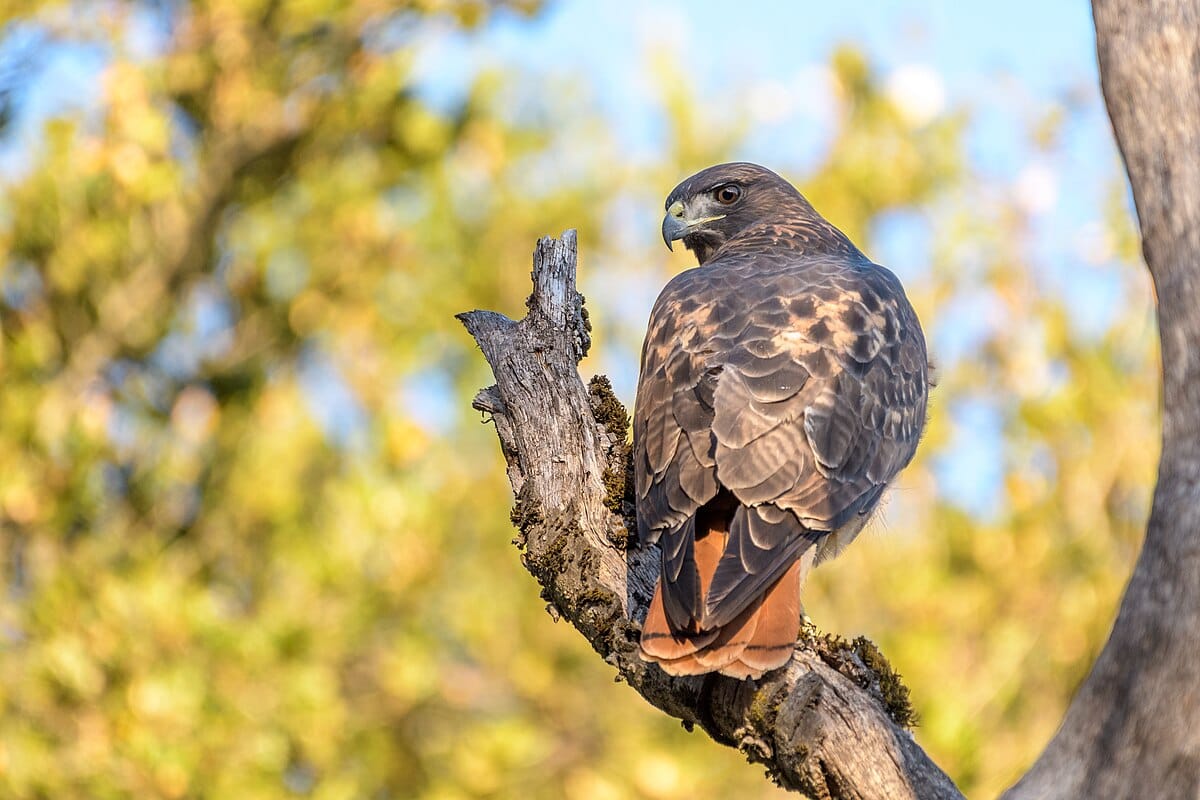
Physical Characteristics
The Red-tailed Hawk is a large raptor, measuring 45–65 cm in length with a wingspan of 110–145 cm. Its most distinctive feature is its reddish-brown tail, visible during flight. The body is brown with a paler underbelly and streaked chest, providing camouflage among trees and open fields. Males are slightly smaller than females.
Behavior
Red-tailed Hawks are diurnal predators, often seen perched on poles or soaring in wide circles while hunting. They are territorial and may vocalize with a high-pitched scream during the breeding season or when defending their area.
Habitat and Range
Widely distributed across North America, they inhabit forests, deserts, grasslands, and urban areas. Adaptability allows them to thrive near roadsides and agricultural lands.
Diet
Primarily carnivorous, feeding on rodents, rabbits, birds, and reptiles. They occasionally scavenge carrion. Their hunting technique includes soaring and sudden dives to capture prey.
Reproduction and Life Cycle
Nesting occurs in tall trees or cliffs. Females lay 1–5 eggs, incubated for about 28–35 days. Fledglings leave the nest after 6–7 weeks but remain dependent on parents for several months.
Fun Facts / Unique Traits
• Known for their piercing eyesight, capable of spotting prey from great heights.
• Their iconic screech is commonly used in movies for generic “bird of prey” sounds.
Human Interaction
Red-tailed Hawks occasionally hunt small pets but are mostly beneficial for controlling rodent populations. They adapt well to urban areas but require large perching sites.
________________________________________
2. Red-shouldered Hawk (Buteo lineatus)
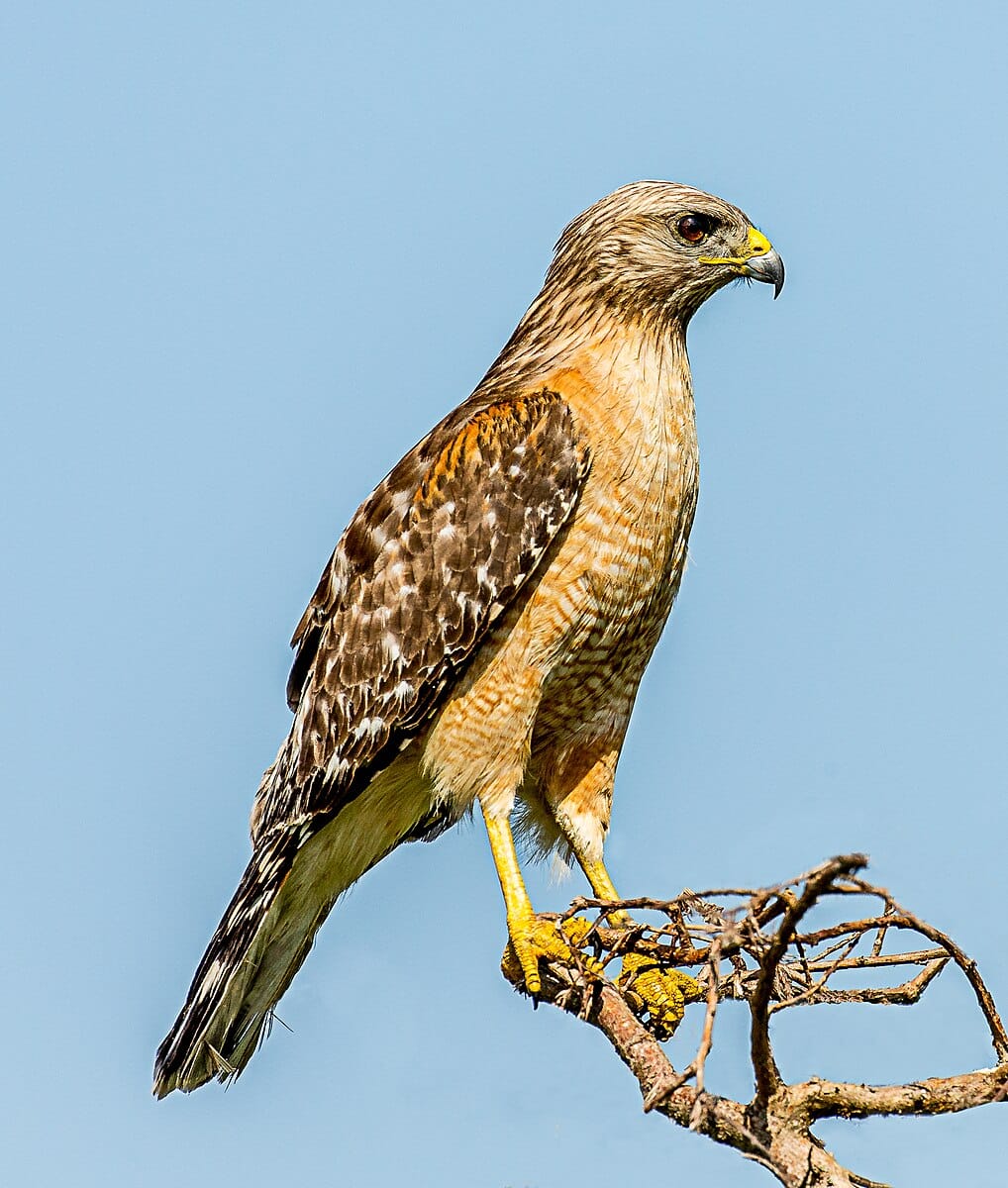
Physical Characteristics
Medium-sized raptor, 43–61 cm in length with a wingspan of 91–127 cm. It has striking reddish shoulders, brownish upperparts, and heavily banded tail feathers. Juveniles are lighter and less vividly marked.
Behavior
Highly vocal and territorial, often seen perched along forest edges or soaring low over wooded areas. Hunts primarily from perches, swooping down to snatch prey.
Habitat and Range
Native to eastern North America, favoring deciduous forests near water. They adapt to swampy woodlands, riverbanks, and suburban areas with large trees.
Diet
Feeds on small mammals, amphibians, reptiles, and occasionally birds. Hunting involves quick dives from elevated perches.
Reproduction and Life Cycle
Nesting occurs in large trees; 2–4 eggs per clutch. Incubation lasts ~33 days, and fledglings leave the nest in 5–6 weeks.
Fun Facts / Unique Traits
• Recognizable by its loud, repetitive “kee-aah” call.
• Often perches near water to hunt frogs and snakes.
Human Interaction
Minimal conflict with humans. Habitat preservation is critical as they rely on large forested areas.
________________________________________
3. Broad-winged Hawk (Buteo platypterus)
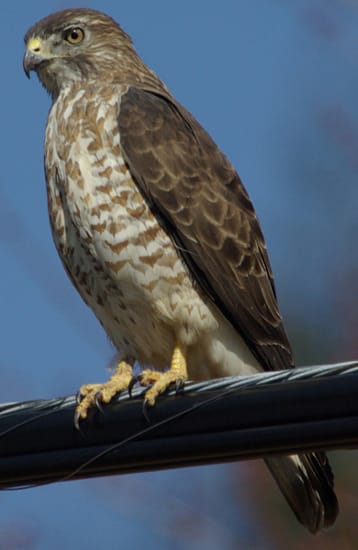
Physical Characteristics
Small-to-medium hawk, 34–49 cm long with a wingspan of 81–110 cm. Features broad wings, dark brown upperparts, and strikingly banded tail feathers. Juveniles are lighter with streaked underparts.
Behavior
Migratory species; forms large wintering flocks called “kettles,” sometimes numbering in the thousands. Hunts primarily from perches or soaring flights.
Habitat and Range
Found in eastern North America, preferring deciduous forests and river valleys. Migrates to Central and South America in winter.
Diet
Feeds on small mammals, amphibians, reptiles, and insects. Opportunistic feeder adapting to seasonal prey availability.
Reproduction and Life Cycle
Nests in trees; 2–4 eggs per clutch. Incubation lasts about 28–33 days. Fledglings leave the nest after 5–6 weeks.
Fun Facts / Unique Traits
• Famous for massive migratory kettles seen in fall.
• Small size and broad wings aid in thermalling during migration.
Human Interaction
Broad-winged Hawks are rarely in conflict with humans and contribute to rodent and insect population control.
________________________________________
4. Rough-legged Hawk (Buteo lagopus)
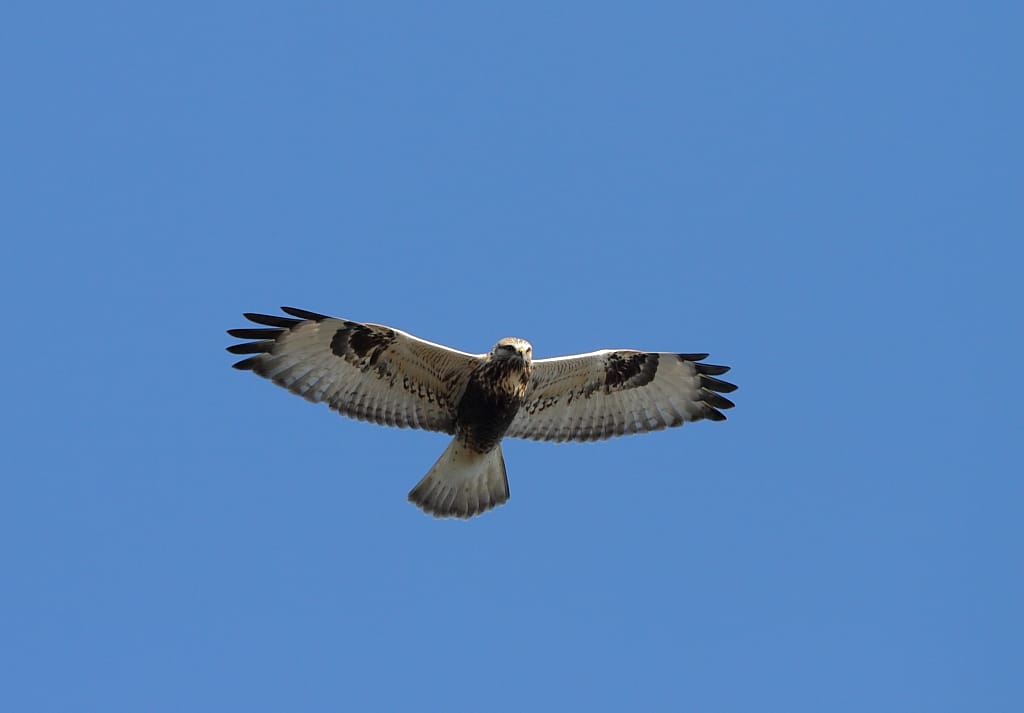
Physical Characteristics
Medium-to-large hawk, 46–60 cm long with a wingspan of 120–152 cm. Distinctive feathered legs, brown mottled upperparts, and pale underparts with a dark belly band.
Behavior
Winter visitor in North America, performing characteristic hovering “kiting” while hunting. Primarily solitary and territorial.
Habitat and Range
Breeds in Arctic tundra; winters in open fields and prairies of southern Canada and northern U.S. Adapted to cold climates.
Diet
Preys on small mammals, especially voles and lemmings. May take birds or carrion opportunistically.
Reproduction and Life Cycle
Breeds in Arctic tundra. Nests are on cliffs or the ground with 3–5 eggs. Incubation lasts ~28–32 days. Fledglings leave in 4–5 weeks.
Fun Facts / Unique Traits
• Feathers on legs provide insulation in Arctic conditions.
• Known for dramatic hovering hunts.
Human Interaction
Rarely interacts with humans; important for rodent population regulation in agricultural regions during winter.
________________________________________
5. Swainson’s Hawk (Buteo swainsoni)
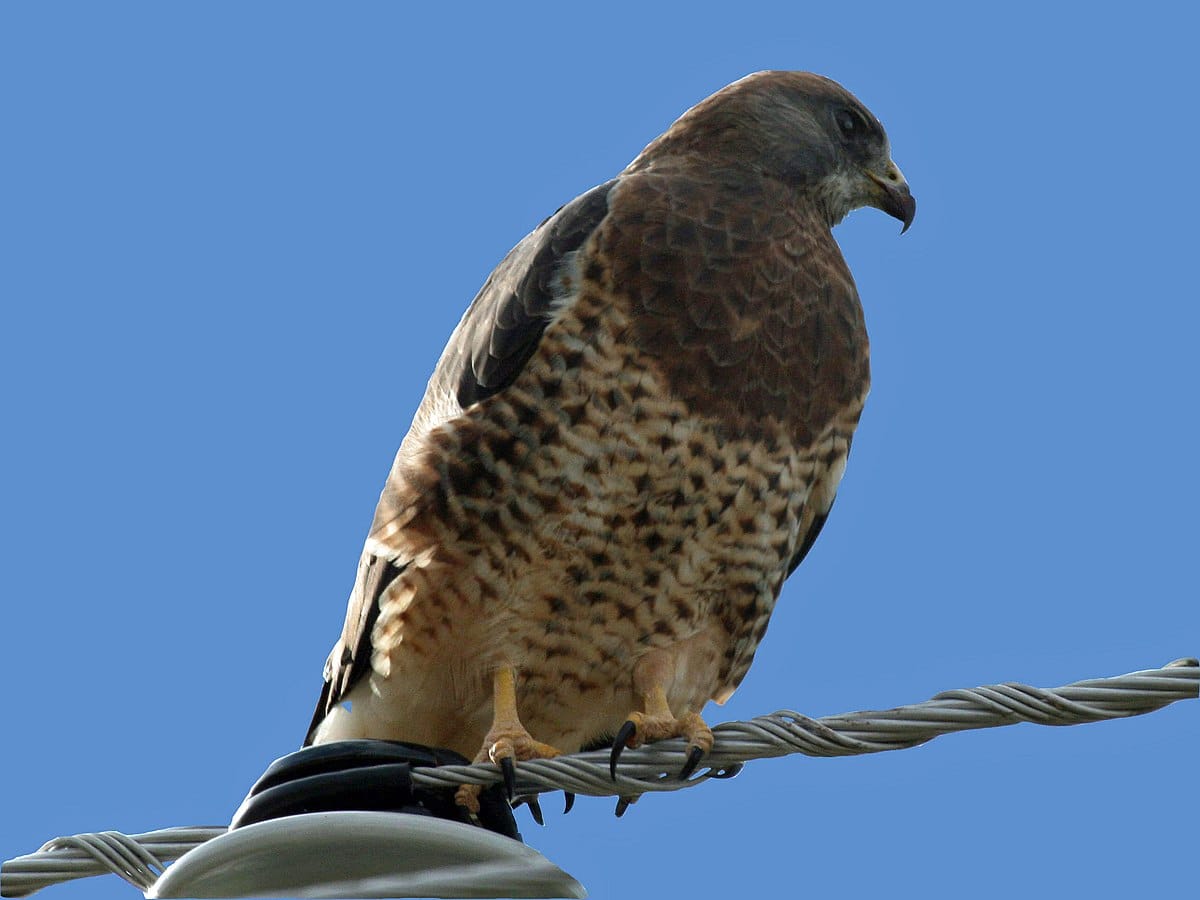
Physical Characteristics
Medium-sized hawk, 46–61 cm long, wingspan 120–150 cm. Slim body, long pointed wings, brown upperparts, and pale underparts. Juveniles show streaked chest and mottled wings.
Behavior
Migratory species; forms large flocks during migration. Hunts in open grasslands by soaring and spotting prey from above.
Habitat and Range
Breeds in North American prairies and grasslands; winters in Argentina and southern South America. Prefers open habitats for hunting small mammals and insects.
Diet
Omnivorous; feeds mainly on grasshoppers and other insects during winter migration, shifting to rodents and small mammals on breeding grounds.
Reproduction and Life Cycle
Nest in trees or cliffs; 3–5 eggs per clutch. Incubation ~28–32 days. Fledglings leave nest in 5–6 weeks.
Fun Facts / Unique Traits
• Famous for long-distance migration, up to 20,000 km annually.
• Can switch diet seasonally, relying heavily on insects during migration.
Human Interaction
Beneficial in controlling grasshopper populations. Sensitive to pesticide use, which can affect migration and survival.
6. Ferruginous Hawk (Buteo regalis)
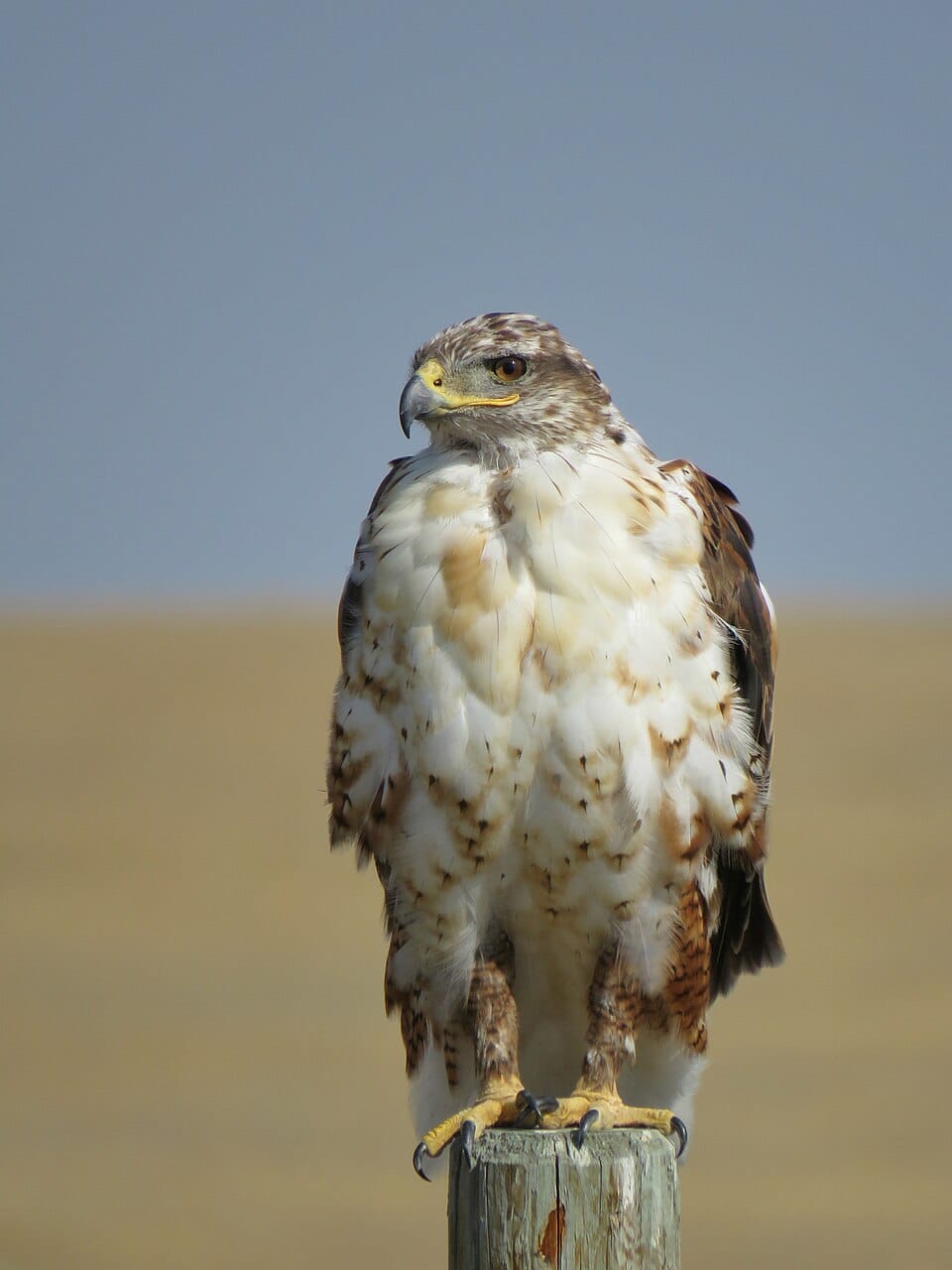
Physical Characteristics
The Ferruginous Hawk is the largest North American Buteo, measuring 51–66 cm in length with a wingspan of 122–152 cm. It has a rusty brown back and pale underparts, sometimes exhibiting a streaked belly. Its long legs and broad wings help it soar efficiently over open plains.
Behavior
Primarily diurnal, it hunts by soaring high and scanning open grasslands for prey. It is relatively solitary and highly territorial during breeding season.
Habitat and Range
Found in the open grasslands, deserts, and shrublands of western North America. Winters in the southern U.S. and northern Mexico.
Diet
Feeds mainly on mammals such as prairie dogs, rabbits, and ground squirrels. Occasionally eats birds and reptiles. Its hunting involves both perching and soaring strategies.
Reproduction and Life Cycle
Nests on cliffs or large trees in open terrain. Lays 2–5 eggs, incubated for 32–36 days. Fledglings leave the nest after 5–6 weeks but remain with parents for several months.
Fun Facts / Unique Traits
• Named for its reddish (ferruginous) plumage.
• Adapted for open habitats with excellent eyesight and soaring ability.
Human Interaction
Beneficial for controlling rodent populations; habitat loss is the main threat. Conservation focuses on grassland preservation.
________________________________________
7. Harlan’s Hawk (Buteo jamaicensis harlani)
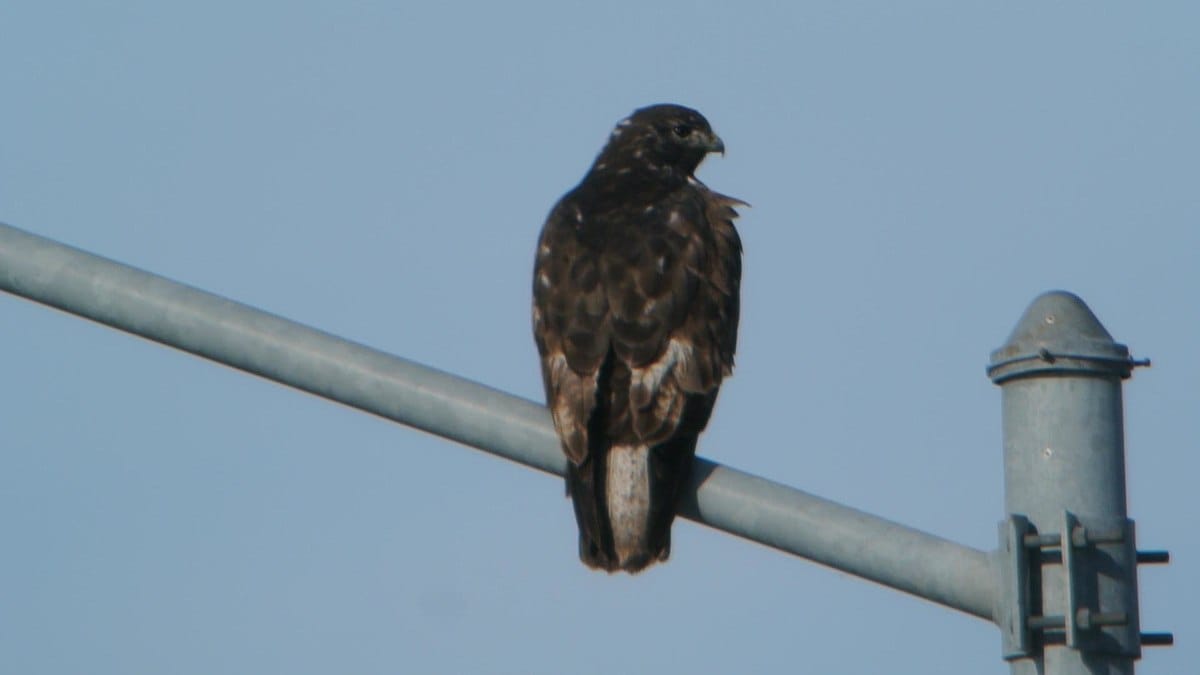
Physical Characteristics
Harlan’s Hawk is a dark morph of the Red-tailed Hawk, featuring nearly black plumage with pale streaking on the chest. Medium-to-large size: 45–65 cm in length, wingspan 114–137 cm.
Behavior
Nocturnal migration is unusual; mostly active during the day. Known for silent gliding and sudden, powerful dives to capture prey.
Habitat and Range
Breeds in Alaska and northwestern Canada; winters in the northern United States. Prefers open woodlands, tundra edges, and river valleys.
Diet
Feeds mainly on small mammals like voles and rabbits, occasionally birds. Uses perching and soaring techniques to locate prey.
Reproduction and Life Cycle
Nests in coniferous trees; 2–4 eggs per clutch. Incubation lasts about 28–32 days. Fledglings remain dependent on parents for 2–3 months.
Fun Facts / Unique Traits
• Considered a dark morph with highly variable plumage.
• Strong adaptation to cold northern climates.
Human Interaction
Rarely conflicts with humans; conservation relies on protecting breeding grounds in northern regions.
________________________________________
8. Zone-tailed Hawk (Buteo albonotatus)
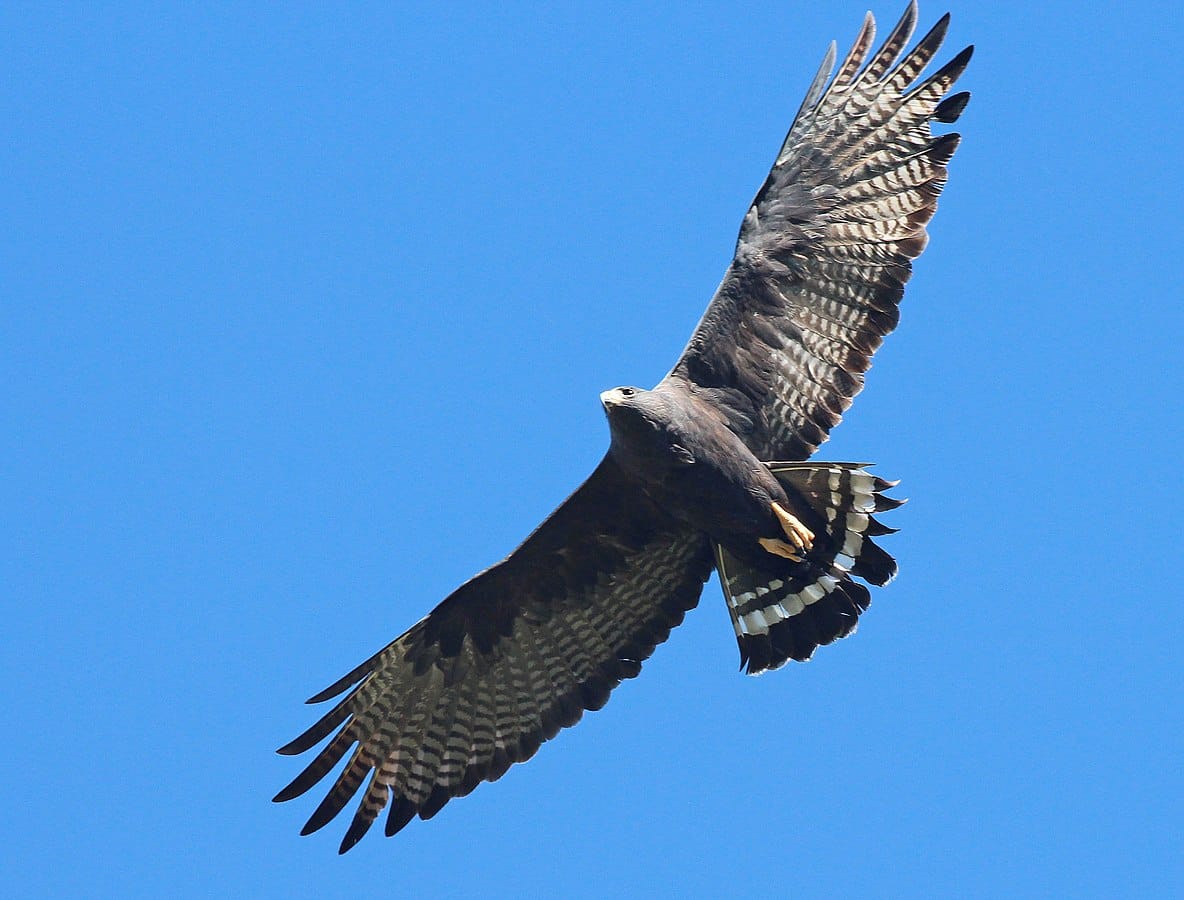
Physical Characteristics
Medium-sized raptor, 45–55 cm long, wingspan 114–135 cm. Dark plumage with lighter banded tail and slender body. Often mistaken for turkey vultures due to similar flight style.
Behavior
Soars and glides in vulture-like flight patterns to ambush prey. Opportunistic hunter; mostly solitary.
Habitat and Range
Found in arid and semi-arid regions of the southwestern U.S., Mexico, and Central America. Prefers canyons, desert scrub, and open woodland edges.
Diet
Feeds on small mammals, birds, and reptiles. Sometimes follows vultures to scavenge disturbed prey.
Reproduction and Life Cycle
Nests in tall trees or cliff ledges. Lays 1–3 eggs per clutch. Incubation ~32–34 days. Fledglings leave the nest at 6–7 weeks.
Fun Facts / Unique Traits
• Mimics turkey vultures to approach prey unnoticed.
• Silent gliding allows surprise attacks.
Human Interaction
Rarely a nuisance; admired by birdwatchers for its vulture-like flight.
________________________________________
9. Sharp-shinned Hawk (Accipiter striatus)
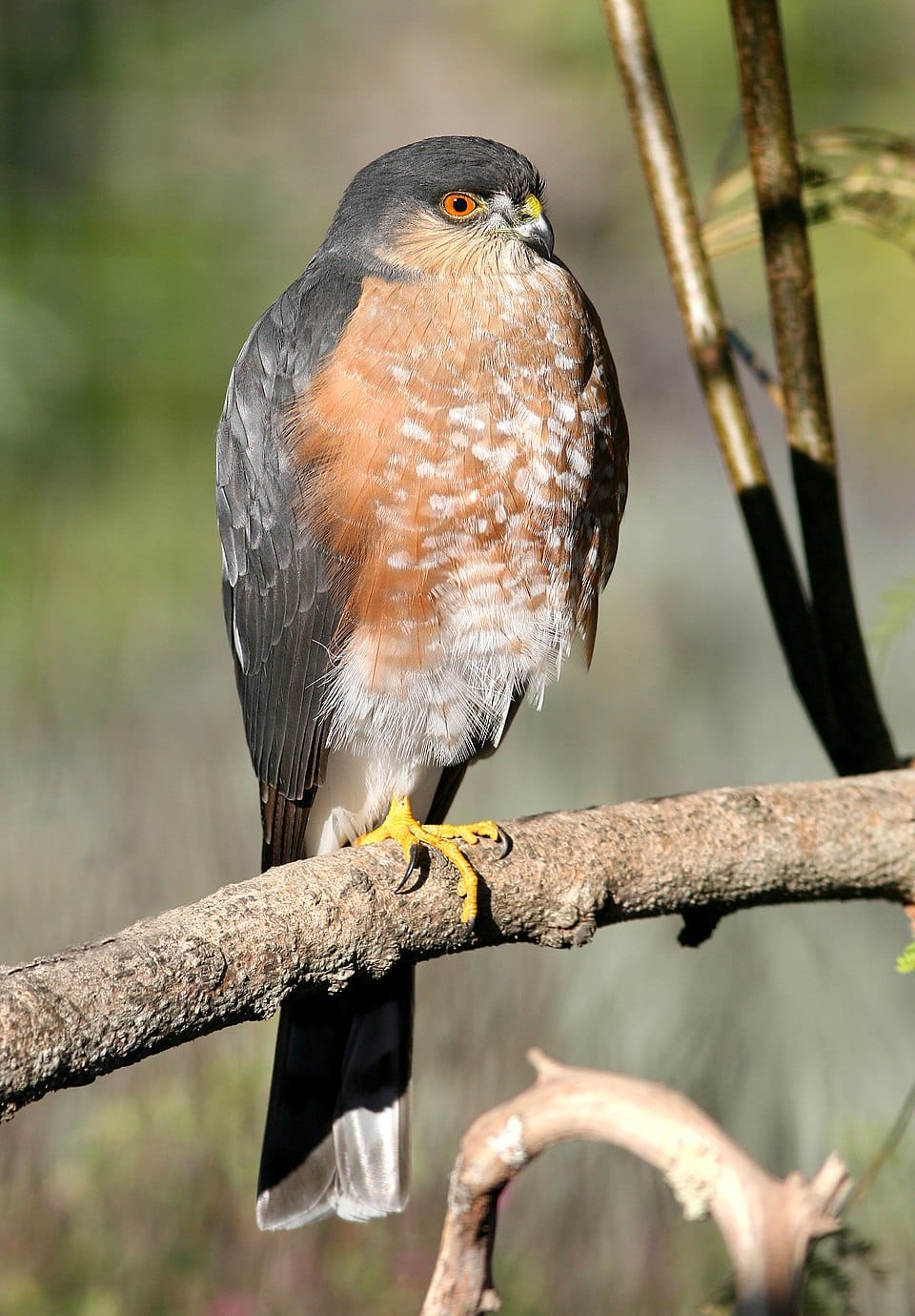
Physical Characteristics
Smallest North American Accipiter, 23–35 cm long, wingspan 42–58 cm. Slim body, short rounded wings, long tail with bands. Males are smaller than females.
Behavior
Highly agile and secretive; hunts birds in dense vegetation. Migratory; often seen flying low through forested areas.
Habitat and Range
Found throughout North America, in forests, woodlands, and suburban areas with abundant bird populations.
Diet
Specializes in small birds and occasionally insects. Hunts with swift, stealthy attacks through dense foliage.
Reproduction and Life Cycle
Nests in dense trees; 3–6 eggs per clutch. Incubation ~30–32 days. Fledglings leave nest at ~4 weeks.
Fun Facts / Unique Traits
• Extremely fast and agile in flight.
• Often mistaken for Cooper’s Hawk, but smaller with a narrower tail.
Human Interaction
Helps control songbird and pest populations; rarely conflicts with humans.
________________________________________
10. Cooper’s Hawk (Accipiter cooperii)
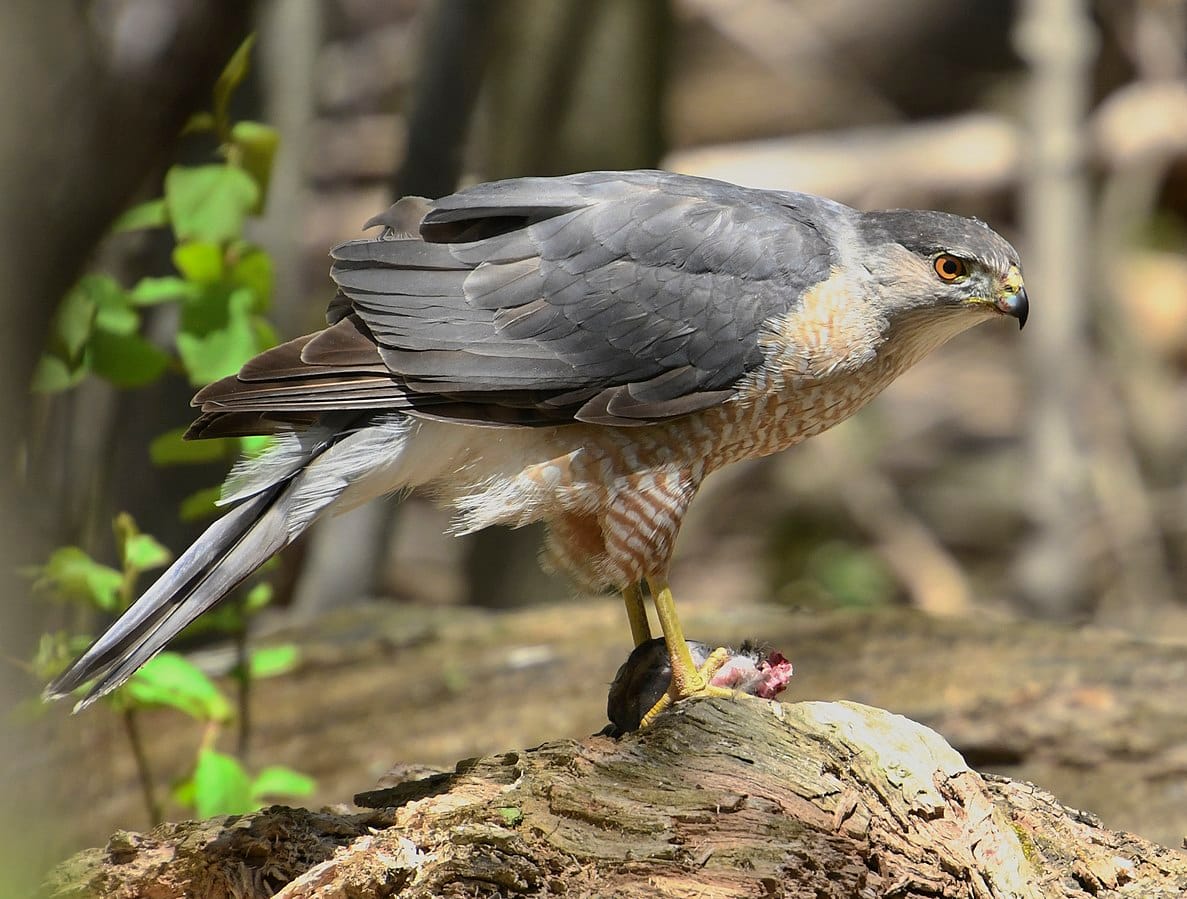
Physical Characteristics
Medium-sized Accipiter, 35–50 cm long, wingspan 62–90 cm. Blue-gray upperparts, reddish barred chest, long rounded tail. Females are larger than males.
Behavior
Agile hunter of birds and small mammals. Migratory in northern populations; often hunts in suburban backyards.
Habitat and Range
Forests, woodlands, and urban areas across North America. Nests in large trees near open areas for hunting.
Diet
Primarily small to medium-sized birds, occasionally mammals. Hunts by stealth and speed, navigating dense foliage with agility.
Reproduction and Life Cycle
Nests built in trees; 3–5 eggs per clutch. Incubation 32–36 days. Fledglings leave nest ~5 weeks after hatching.
Fun Facts / Unique Traits
• Adapted to urban areas, often hunting backyard songbirds.
• Exhibits impressive maneuverability in flight.
Human Interaction
Generally beneficial for controlling pest bird populations; admired by birdwatchers for urban sightings.
11. Northern Goshawk (Accipiter gentilis)
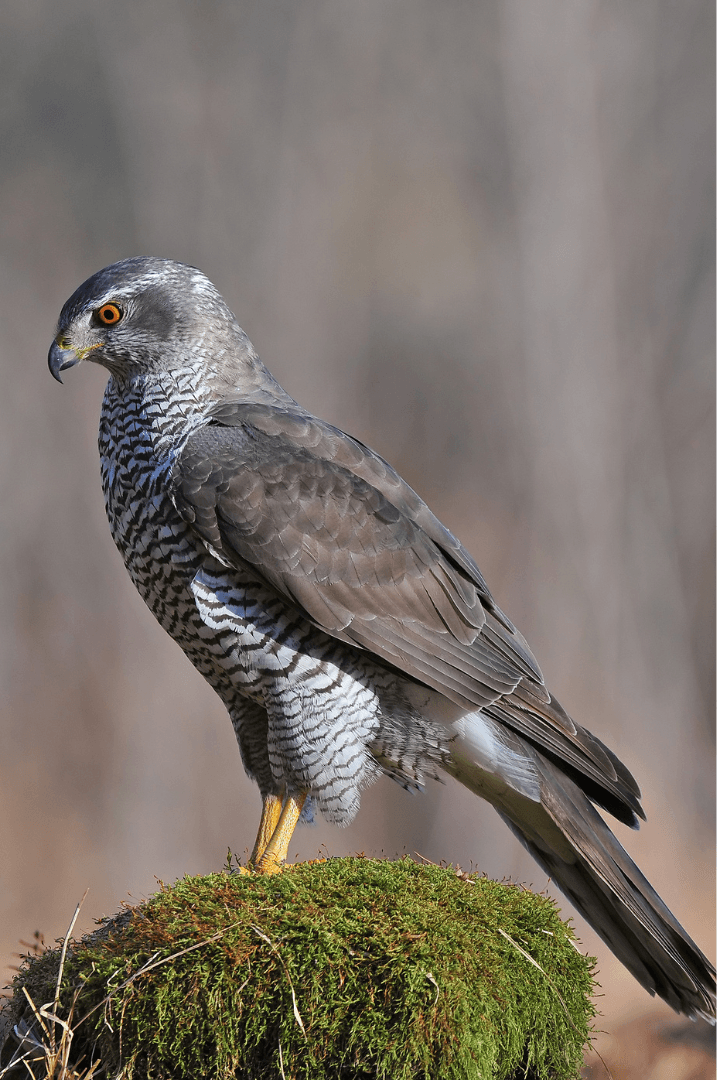
Physical Characteristics
The Northern Goshawk is a large and powerful Accipiter, measuring 46–61 cm in length with a wingspan of 102–127 cm. Adults have slate-gray upperparts, a white underbelly with fine horizontal barring, and striking red or orange eyes. Females are noticeably larger than males.
Behavior
Highly territorial and aggressive, especially during the breeding season. Hunts in dense forests using agility and speed to catch birds and mammals. Often remains hidden until attacking prey.
Habitat and Range
Found across North America, Europe, and Asia. Prefers mature forests and woodland areas but may venture to forest edges and open meadows for hunting.
Diet
Feeds mainly on birds (from songbirds to ducks) and small mammals. Hunting strategy includes stealthy approaches and sudden bursts of speed through trees.
Reproduction and Life Cycle
Nests in large trees; 3–5 eggs per clutch. Incubation lasts about 30–38 days. Fledglings leave the nest after 5–6 weeks but remain with parents for further hunting training.
Fun Facts / Unique Traits
• Known for exceptional agility in dense forests.
• Can attack much larger prey relative to its size.
Human Interaction
Generally avoids humans but may nest near trails. Considered beneficial for controlling bird and mammal populations in forests.
________________________________________
12. Chinese Sparrowhawk (Accipiter soloensis)
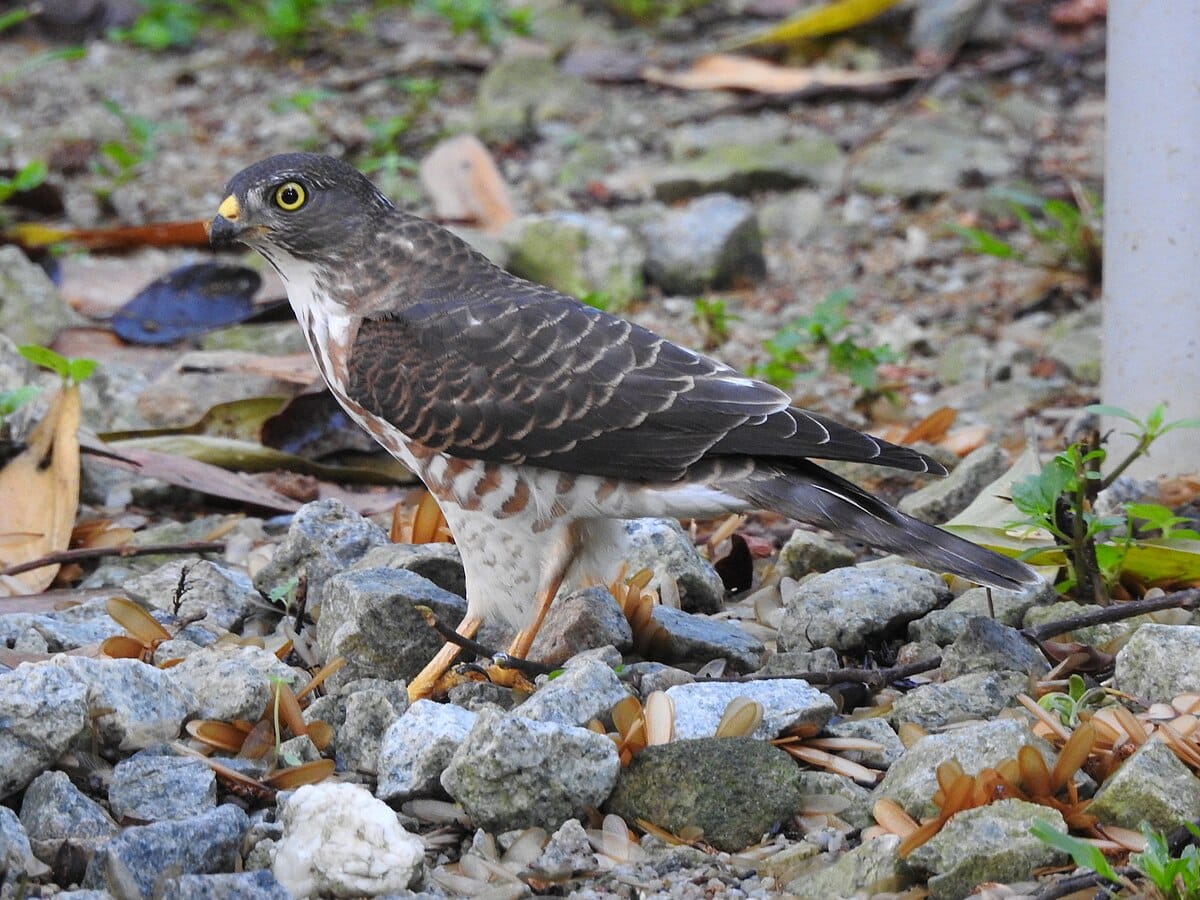
Physical Characteristics
Small raptor, 28–35 cm in length with a wingspan of 55–70 cm. Brown upperparts, pale underparts with vertical streaks, and yellow eyes. Males are slightly smaller than females.
Behavior
Migratory species; known for agile flight and hunting small birds and insects. Often hunts near forest edges and agricultural fields.
Habitat and Range
Breeds in East Asia (China, Korea, Japan) and migrates to Southeast Asia during winter. Prefers woodlands and open forests.
Diet
Primarily small birds and insects. Hunts with stealth and quick, direct attacks.
Reproduction and Life Cycle
Nests in trees; clutch size of 3–5 eggs. Incubation lasts ~28 days. Fledglings leave the nest around 4–5 weeks old.
Fun Facts / Unique Traits
• Small size allows it to navigate dense vegetation easily.
• Seasonal migration covers long distances across Asia.
Human Interaction
Occasionally spotted in agricultural areas, controlling pest birds and insects. Rarely conflicts with humans.
________________________________________
13. Eurasian Sparrowhawk (Accipiter nisus)
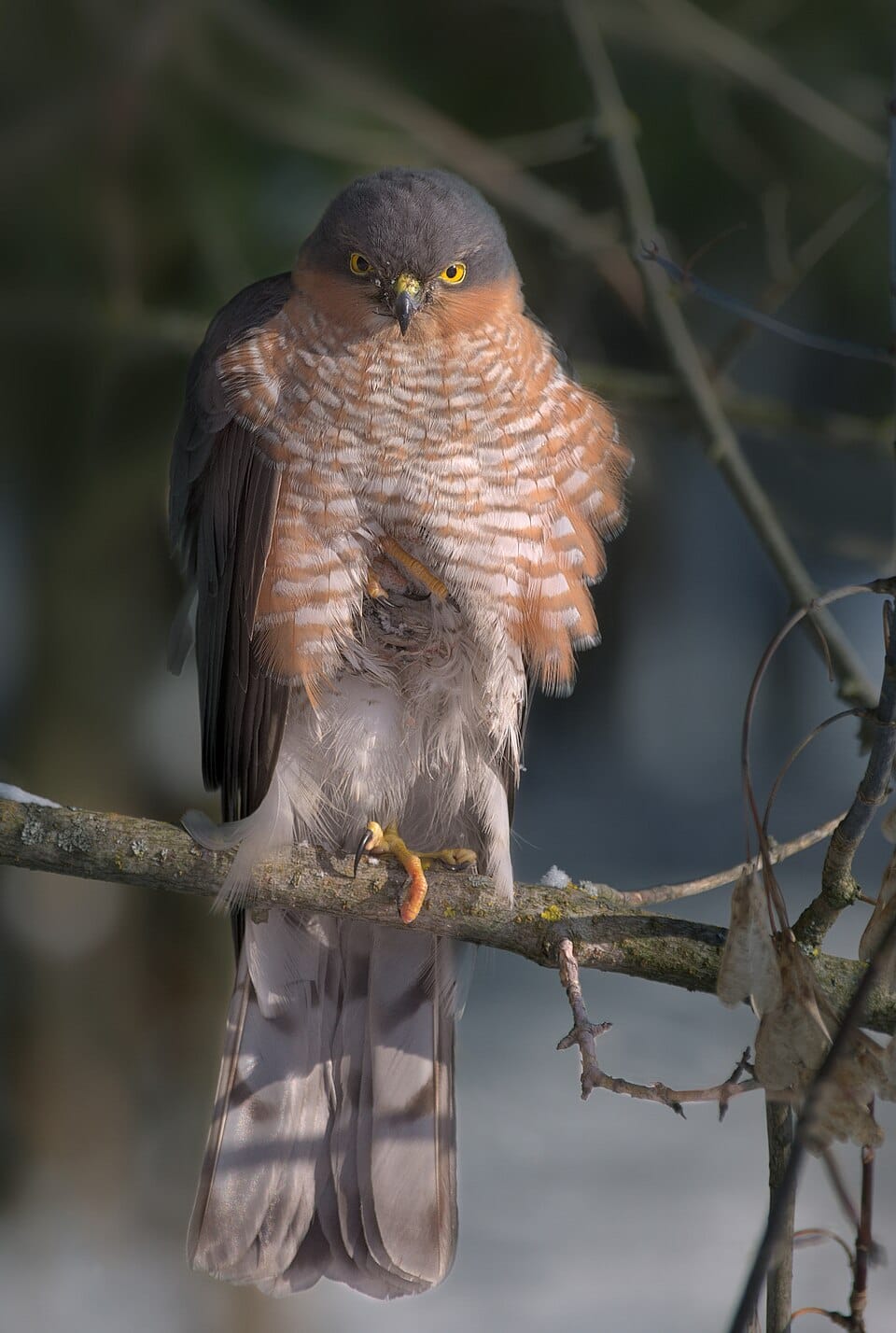
Physical Characteristics
Small raptor, 29–38 cm in length, wingspan 58–70 cm. Males have blue-gray upperparts and orange-barred underparts; females are larger with brown upperparts.
Behavior
Agile hunter of small birds; often soars or flits quickly through trees. Solitary and territorial.
Habitat and Range
Common across Europe and parts of Asia. Prefers woodlands, forest edges, and occasionally urban parks and gardens.
Diet
Feeds almost exclusively on small birds but occasionally takes mammals. Uses stealth and speed to surprise prey.
Reproduction and Life Cycle
Nests in dense trees; 3–6 eggs per clutch. Incubation ~33 days; fledglings leave nest at ~4–5 weeks.
Fun Facts / Unique Traits
• Often hunts in suburban areas, preying on house sparrows.
• Small size allows excellent maneuverability in dense foliage.
Human Interaction
Beneficial for bird population control. Often admired by birdwatchers in urban environments.
________________________________________
14. Shikra (Accipiter badius)
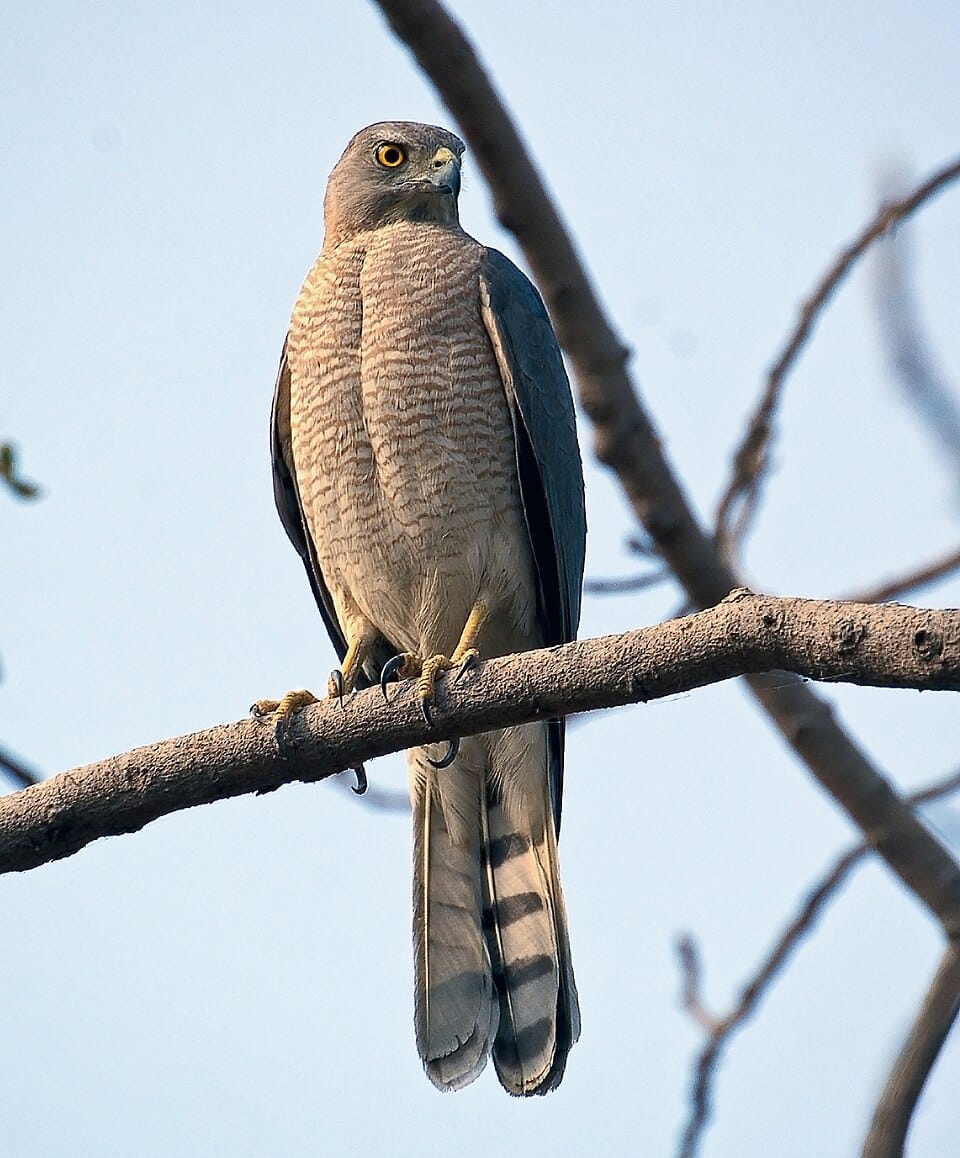
Physical Characteristics
Small raptor, 26–30 cm long with a wingspan of 50–65 cm. Grey upperparts, whitish underparts with fine barring, yellow legs, and red eyes.
Behavior
Agile and swift hunter of birds, insects, and small mammals. Active during the day; known for surprise attacks from perches.
Habitat and Range
Found throughout Asia and Africa in forests, open woodlands, and urban gardens. Highly adaptable to different environments.
Diet
Primarily small birds, lizards, insects, and occasionally rodents. Hunts with stealth and speed.
Reproduction and Life Cycle
Nests in trees; lays 3–5 eggs per clutch. Incubation ~28–32 days. Fledglings leave the nest after ~4–5 weeks.
Fun Facts / Unique Traits
• Highly adaptable to urban areas.
• Can quickly dart through dense foliage to capture prey.
Human Interaction
Occasionally seen near human settlements, controlling pest birds and insects.
________________________________________
15. Gabar Goshawk (Micronisus gabar)
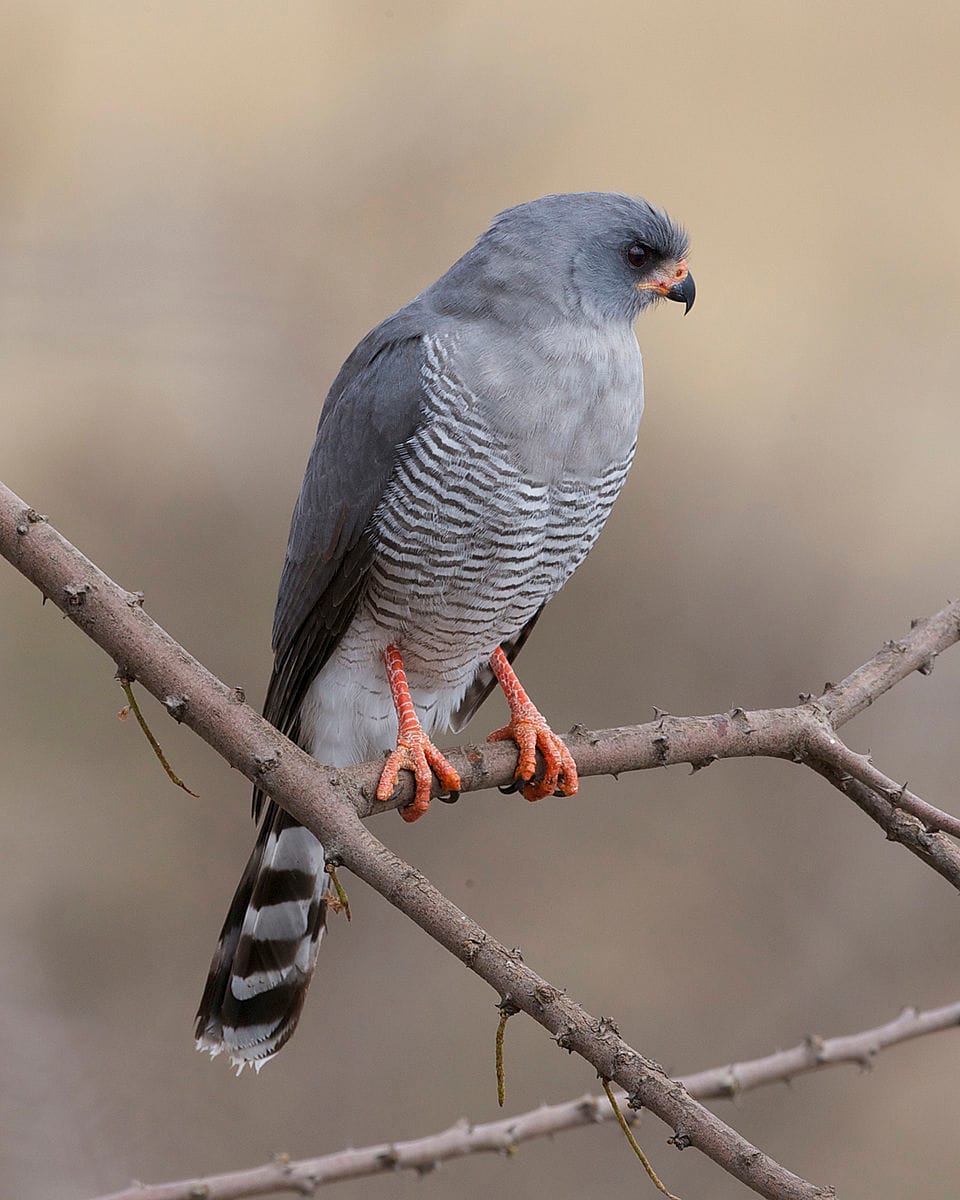
Physical Characteristics
Small-to-medium raptor, 29–36 cm long, wingspan 60–75 cm. Grey upperparts, finely barred underparts, and yellow eyes. Females are slightly larger than males.
Behavior
Fast and agile hunter of birds, reptiles, and large insects. Often hunts by stealth in woodlands or open savannahs.
Habitat and Range
Sub-Saharan Africa; prefers open woodlands, savannahs, and scrub areas. Adapted to drier climates.
Diet
Feeds mainly on small birds, lizards, and large insects. Uses surprise attacks from perches or during low gliding flights.
Reproduction and Life Cycle
Nests in trees or dense shrubs; 2–4 eggs per clutch. Incubation lasts about 30 days. Fledglings leave the nest after ~4–5 weeks.
Fun Facts / Unique Traits
• Exceptional hunter of small, agile birds.
• Can thrive in semi-arid habitats where other hawks are less common.
Human Interaction
Beneficial in controlling pest bird populations. Rarely comes into conflict with humans due to small prey preference.
16. Bat Hawk (Macheiramphus alcinus)
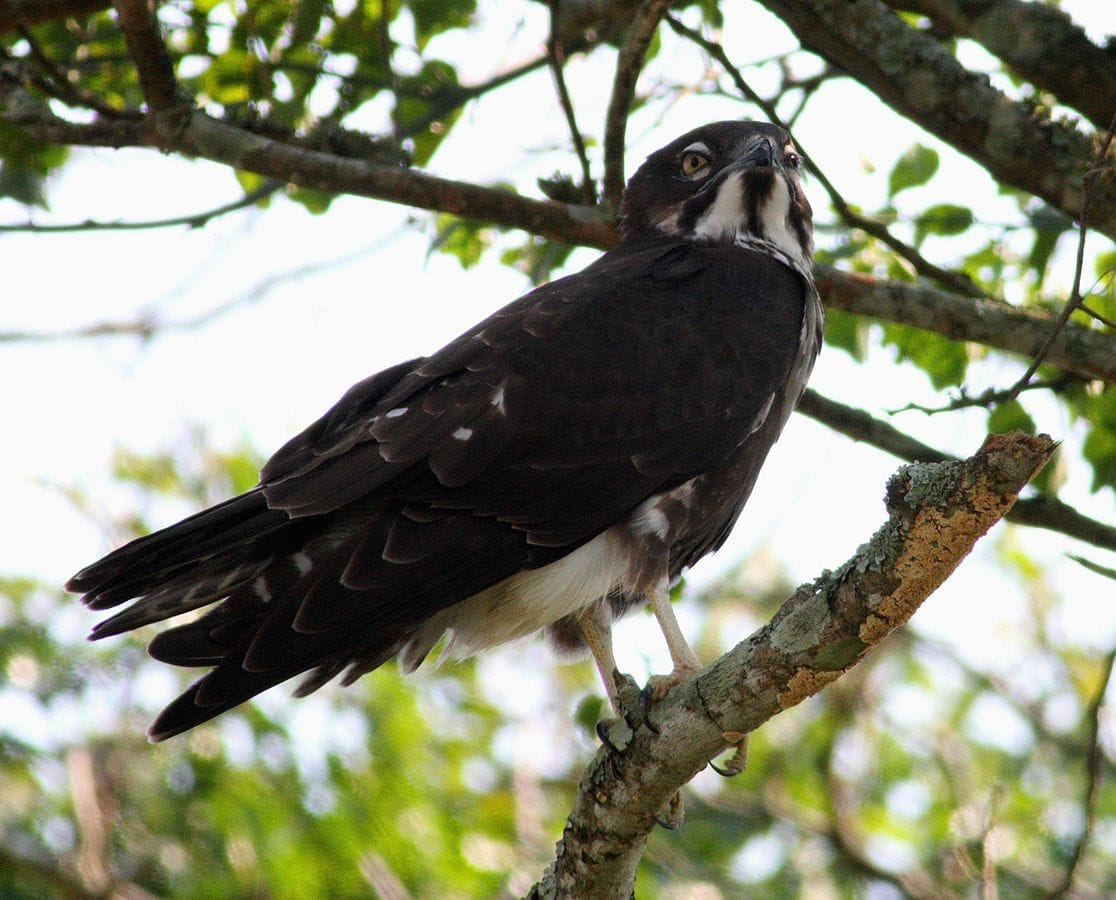
Physical Characteristics
The Bat Hawk is a small raptor, 35–43 cm in length with a wingspan of 84–97 cm. It has dark brown to black plumage with long wings and a deeply forked tail, giving it excellent maneuverability for hunting at dusk.
Behavior
Primarily crepuscular, active at dawn and dusk. Specializes in hunting bats and large insects in flight. Highly agile, often catching prey mid-air with rapid dives and sharp turns.
Habitat and Range
Found across sub-Saharan Africa, Southeast Asia, and northern Australia. Prefers forest edges, river valleys, and areas near bat colonies.
Diet
Feeds almost exclusively on bats and large nocturnal insects. Hunts by swift, aerial attacks during twilight hours.
Reproduction and Life Cycle
Nests in trees near bat colonies. Lays 1–2 eggs per clutch. Incubation lasts ~30–32 days, with fledglings leaving the nest after 5–6 weeks.
Fun Facts / Unique Traits
• Specialized adaptations allow precise aerial hunting in low light.
• Considered one of the most efficient bat predators among raptors.
Human Interaction
Rarely interacts with humans; conservation is tied to preserving bat habitats.
________________________________________
17. Grey-faced Buzzard (Butastur indicus)
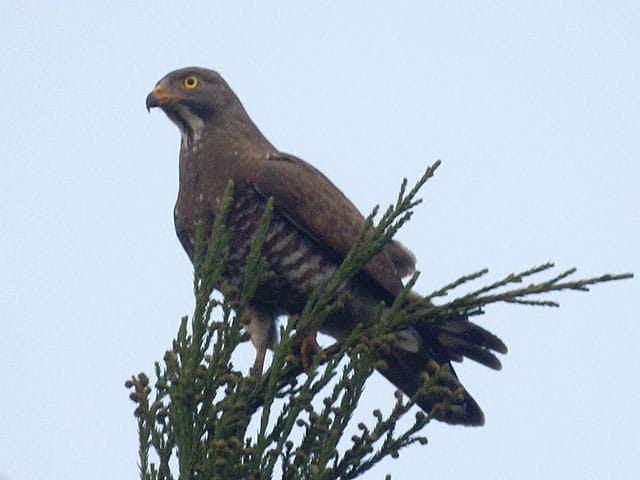
Physical Characteristics
Medium-sized raptor, 46–56 cm long, wingspan 110–125 cm. Grey face and head with brown upperparts and barred underparts. Slender body and long tail aid in agile flight.
Behavior
Diurnal hunter; perches and soars to locate prey. Migratory in East Asia, traveling thousands of kilometers between breeding and wintering grounds.
Habitat and Range
Breeds in Japan, Korea, and eastern China; winters in Southeast Asia. Prefers forests, open woodland edges, and agricultural areas.
Diet
Feeds on insects, small mammals, reptiles, and amphibians. Uses keen eyesight and sudden swoops to capture prey.
Reproduction and Life Cycle
Nests in trees; clutch size 2–4 eggs. Incubation ~28–32 days, with fledglings leaving nest after ~5 weeks.
Fun Facts / Unique Traits
• Known for long migratory journeys across Asia.
• Often hunts near rice paddies and open fields.
Human Interaction
Beneficial predator in agricultural areas, controlling insect and rodent populations.
________________________________________
18. Crested Goshawk (Accipiter trivirgatus)
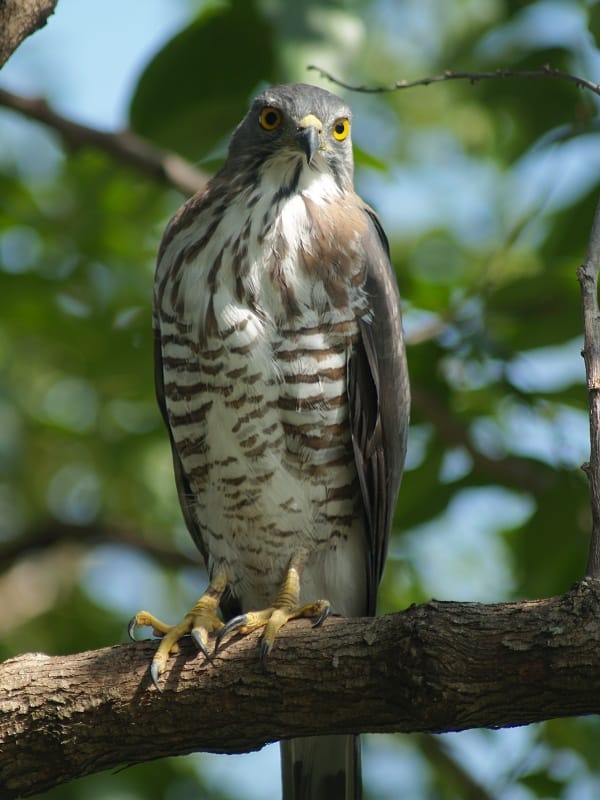
Physical Characteristics
Medium-sized raptor, 30–46 cm long, wingspan 60–95 cm. Grey-brown upperparts, finely barred underparts, and a noticeable crest on the head.
Behavior
Secretive and agile hunter; captures birds, reptiles, and small mammals. Perches silently before a rapid strike.
Habitat and Range
Found across South and Southeast Asia, including India, Indonesia, and the Philippines. Prefers forests, woodland edges, and sometimes urban parks.
Diet
Feeds on birds, lizards, and small mammals. Hunting involves stealth and speed.
Reproduction and Life Cycle
Nests in dense trees; lays 2–4 eggs. Incubation lasts ~28–32 days. Fledglings leave the nest at about 4–5 weeks.
Fun Facts / Unique Traits
• Adaptable to urban environments with suitable tree cover.
• Crest can be raised when alarmed or excited.
Human Interaction
Rarely conflicts with humans; contributes to controlling pest bird populations.
________________________________________
19. Japanese Sparrowhawk (Accipiter gularis)
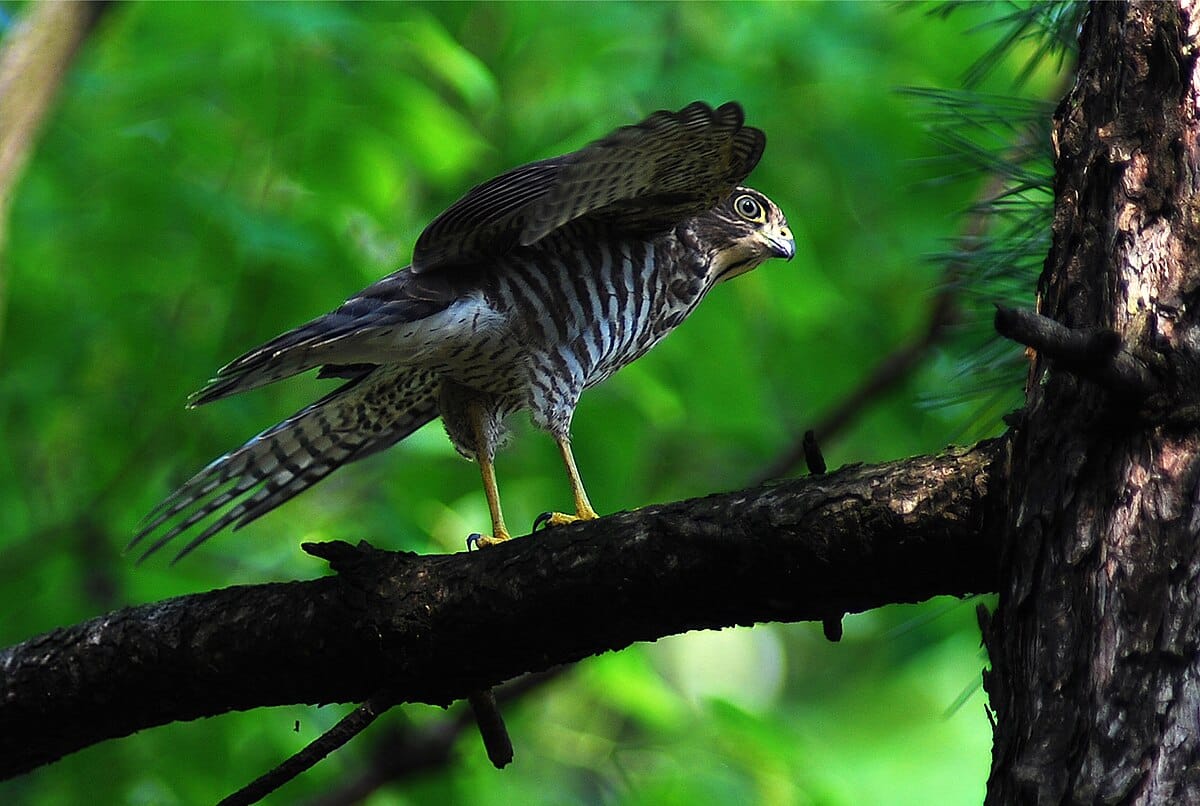
Physical Characteristics
Small raptor, 24–30 cm long with a wingspan of 50–65 cm. Males have grey upperparts and orange-barred underparts; females are larger with brown upperparts.
Behavior
Migratory species; hunts small birds and insects with swift, precise flight. Often flies through forest canopies in pursuit of prey.
Habitat and Range
Breeds in Japan, Korea, and eastern China; winters in Southeast Asia. Prefers forests, woodland edges, and river valleys.
Diet
Feeds mainly on small birds and insects. Employs stealth, speed, and maneuverability to catch prey.
Reproduction and Life Cycle
Nests in trees; clutch of 3–5 eggs. Incubation ~28 days. Fledglings leave the nest around 4 weeks.
Fun Facts / Unique Traits
• Highly migratory with long-distance flights.
• Excellent maneuverability makes it a skilled forest hunter.
Human Interaction
Rarely interacts with humans; helps control insect and small bird populations in forests and agricultural areas.
________________________________________
20. Besra (Accipiter virgatus)
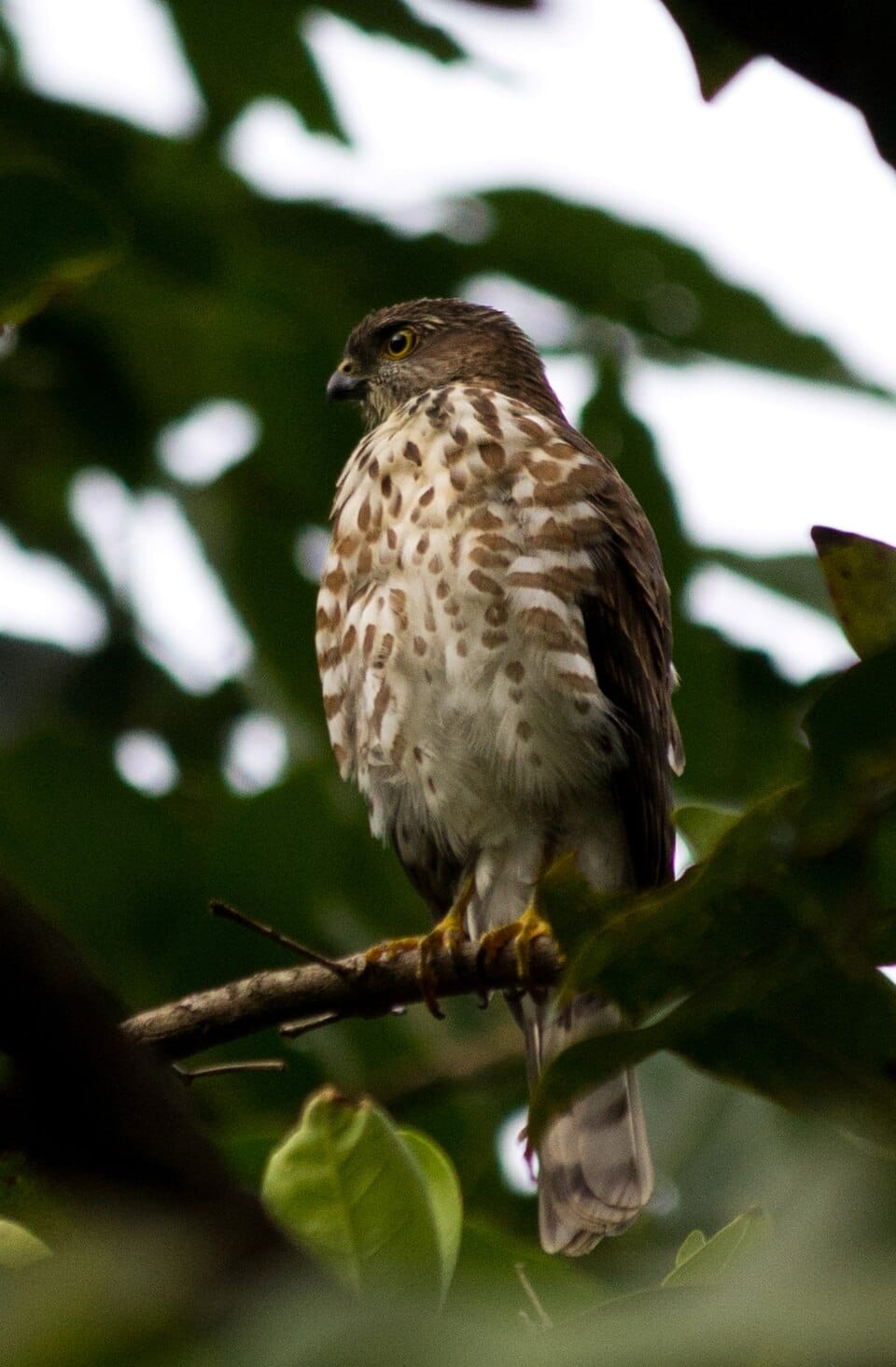
Physical Characteristics
Small Accipiter, 25–30 cm long, wingspan 50–65 cm. Brown upperparts, barred underparts, yellow legs, and piercing yellow eyes.
Behavior
Fast and agile hunter of birds, lizards, and insects. Uses stealth and surprise attacks in dense forest environments.
Habitat and Range
Found across South and Southeast Asia, including India, Indonesia, and Malaysia. Prefers forests, wooded hills, and forest edges.
Diet
Feeds primarily on small birds, reptiles, and large insects. Hunts by short, rapid flights through dense foliage.
Reproduction and Life Cycle
Nests in dense trees; lays 2–4 eggs per clutch. Incubation lasts ~28–32 days. Fledglings leave nest after 4–5 weeks.
Fun Facts / Unique Traits
• Exceptional agility makes it a formidable predator in dense forests.
• Often observed silently stalking prey before a rapid strike.
Human Interaction
Beneficial in controlling pest bird and insect populations. Rarely seen outside forested habitats.
21. Collared Falconet (Microhierax caerulescens)
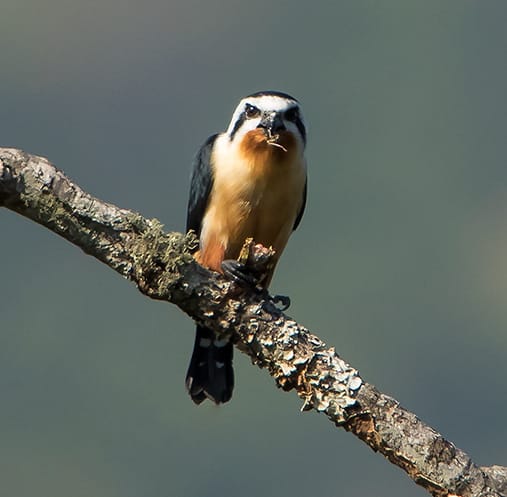
Physical Characteristics
The Collared Falconet is a tiny raptor, measuring just 14–17 cm in length with a wingspan of 27–32 cm. It has black and white plumage with a striking black collar around its neck and bright red eyes. Its small size allows for exceptional maneuverability.
Behavior
Highly active and agile, often perching conspicuously while hunting. Hunts primarily in pairs or small family groups. Known for quick, darting flights to capture prey.
Habitat and Range
Found across Southeast Asia, including India, Nepal, Thailand, and Malaysia. Prefers open forests, forest edges, and cultivated areas with scattered trees.
Diet
Feeds mainly on insects, small birds, and lizards. Uses stealth and rapid aerial attacks to capture prey.
Reproduction and Life Cycle
Nests in tree cavities or abandoned woodpecker holes. Clutch size 3–5 eggs. Incubation lasts ~28 days, with fledglings leaving the nest after 4–5 weeks.
Fun Facts / Unique Traits
• One of the smallest raptors in the world.
• Exhibits remarkable agility for hunting small, fast-moving prey.
Human Interaction
Generally avoids humans; can benefit agriculture by controlling insect populations.
________________________________________
22. Pygmy Falcon (Polihierax semitorquatus)
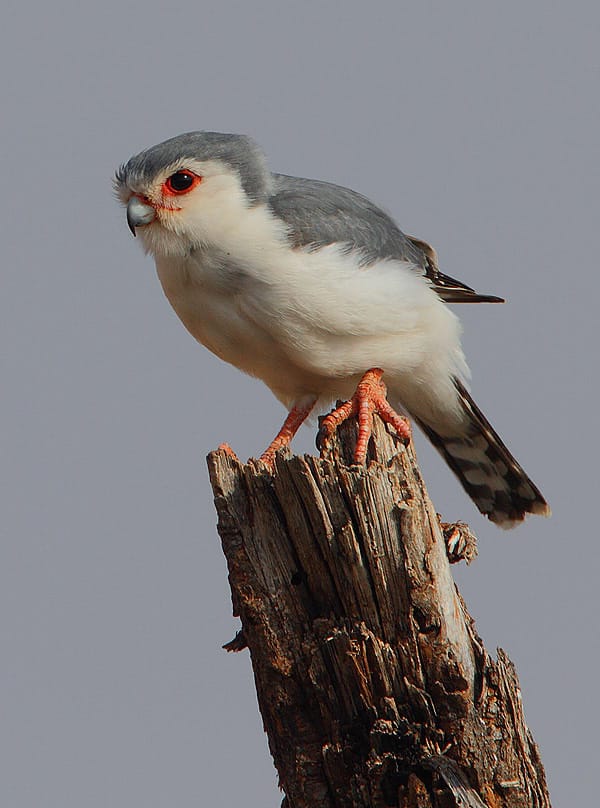
Physical Characteristics
A small falcon, 18–21 cm long with a wingspan of 30–35 cm. Males have slate-gray upperparts and rufous underparts, while females are browner. Short wings and tail enhance maneuverability.
Behavior
Diurnal and highly active. Hunts insects, small birds, and reptiles. Often seen perching upright on exposed branches before sudden strikes.
Habitat and Range
Found in Eastern and Southern Africa, including Kenya, Tanzania, and South Africa. Prefers savannahs, thornbush areas, and open woodlands.
Diet
Feeds on insects, lizards, and occasionally small birds. Hunting involves short bursts of rapid flight.
Reproduction and Life Cycle
Nests in tree cavities or old nests of other birds. Clutch size 2–4 eggs. Incubation lasts ~28 days. Fledglings leave the nest after ~5 weeks.
Fun Facts / Unique Traits
• Extremely small yet fierce predator in its habitat.
• Often associates with weaverbird colonies for nesting sites.
Human Interaction
Minimal human conflict; contributes to controlling pest insects and small vertebrates.
________________________________________
23. Mississippi Kite (Ictinia mississippiensis)
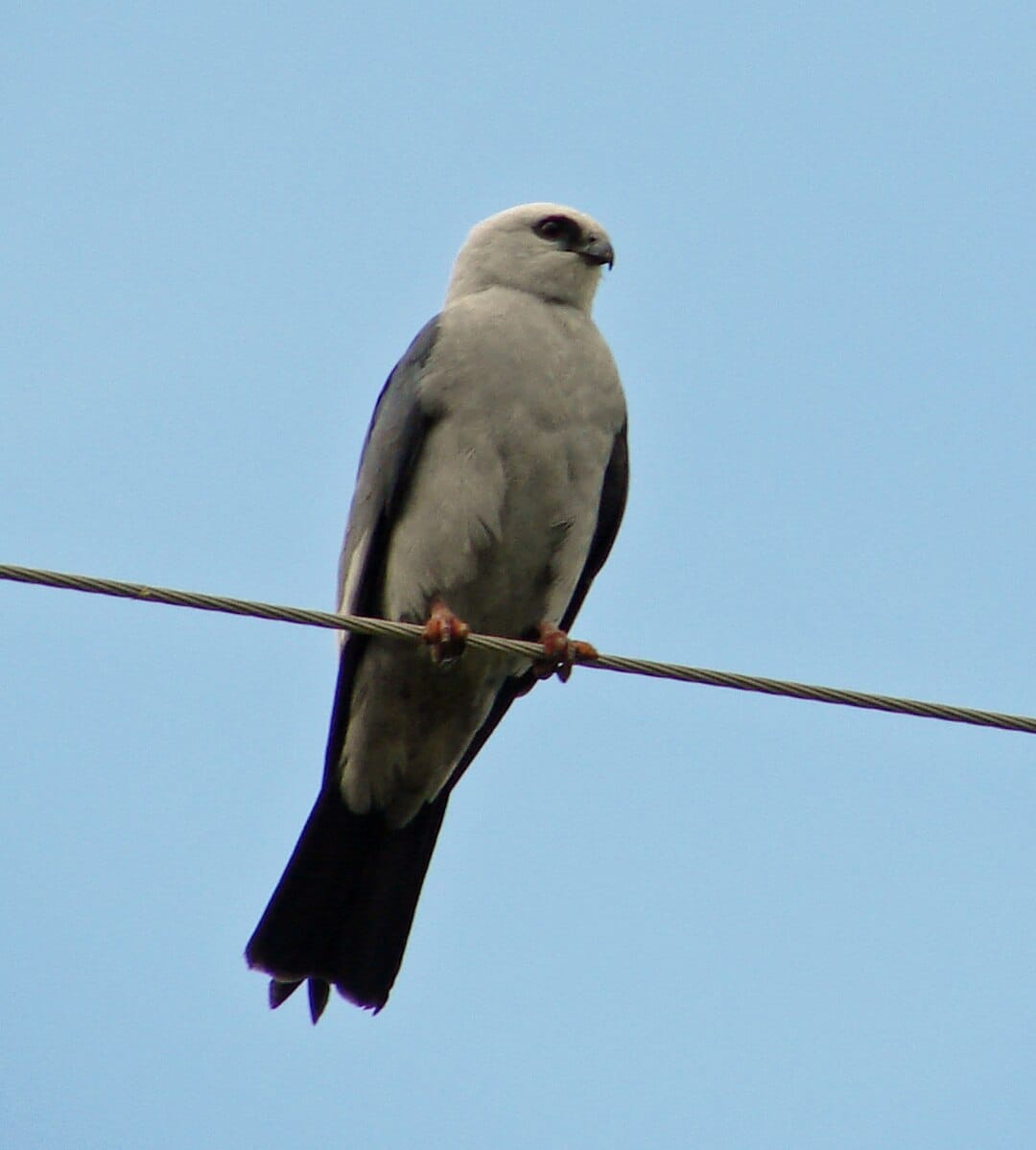
Physical Characteristics
Medium-sized raptor, 36–46 cm long with a wingspan of 84–105 cm. Adults have slate-gray upperparts, lighter underparts, and red eyes. Long, pointed wings facilitate graceful gliding.
Behavior
Highly aerial; feeds while in flight. Often seen in large flocks during migration, performing acrobatic maneuvers to catch insects.
Habitat and Range
Breeds in the southeastern United States and winters in South America. Prefers open woodlands, riversides, and farmlands.
Diet
Primarily consumes large flying insects, occasionally small birds and reptiles. Hunts almost exclusively on the wing.
Reproduction and Life Cycle
Nests in tall trees; clutch size 3–4 eggs. Incubation lasts ~28 days. Fledglings leave nest after ~5–6 weeks.
Fun Facts / Unique Traits
• Known for graceful aerial acrobatics.
• Highly social, especially during migration.
Human Interaction
Beneficial for controlling insect populations. Often admired by birdwatchers during migration events.
________________________________________
24. Swallow-tailed Kite (Elanoides forficatus)
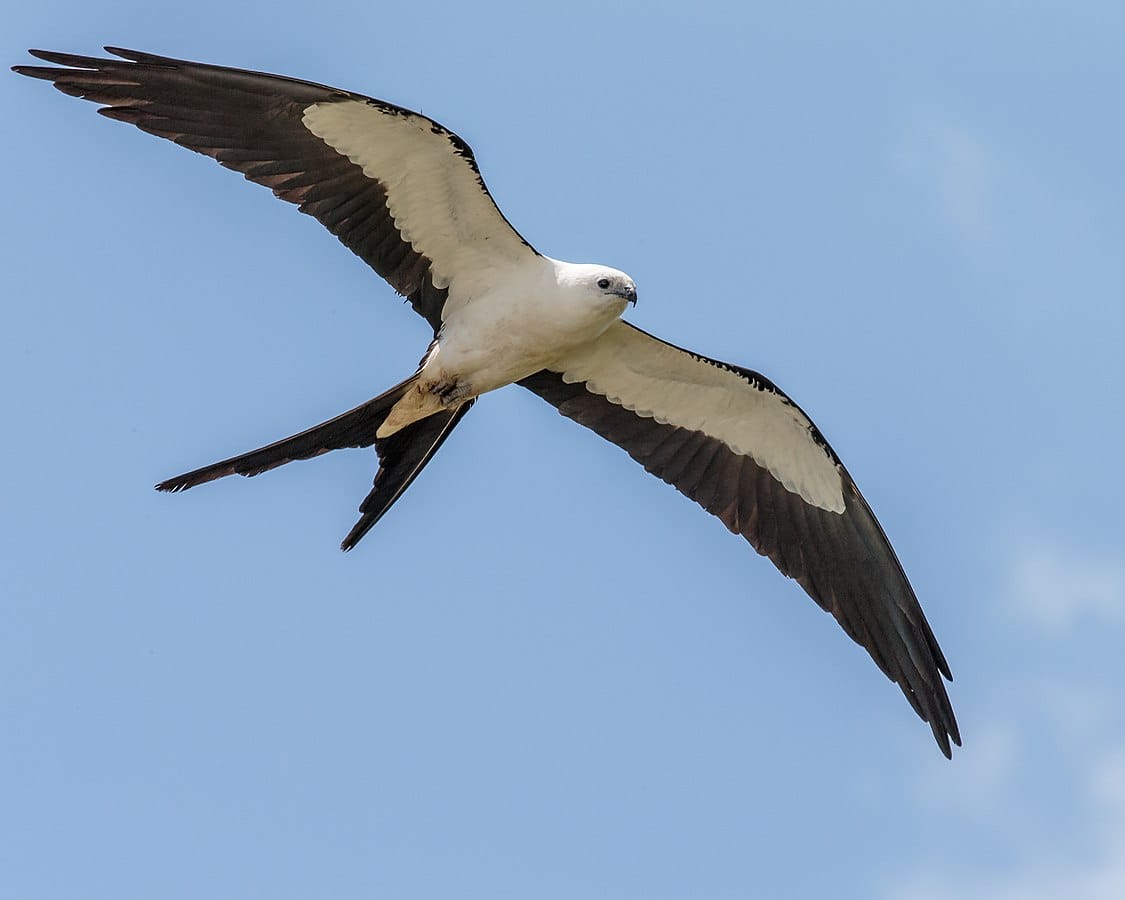
Physical Characteristics
Medium raptor, 47–56 cm long with a wingspan of 110–130 cm. Sleek black and white plumage with a deeply forked tail, which provides excellent maneuverability in flight.
Behavior
Aerial specialist, catching insects and small vertebrates mid-flight. Known for graceful gliding and sweeping turns while hunting.
Habitat and Range
Breeds in the southeastern United States; winters in South America. Prefers wetlands, river valleys, and forest edges.
Diet
Feeds primarily on insects and small reptiles captured in flight. Rarely takes prey from the ground.
Reproduction and Life Cycle
Nests in tall trees, often near water. Clutch size 2–3 eggs. Incubation ~30 days; fledglings leave nest after 5–6 weeks.
Fun Facts / Unique Traits
• Named for its distinctive swallow-like tail.
• Exhibits extraordinary aerial acrobatics.
Human Interaction
Non-aggressive to humans; valued for natural pest control and scenic birdwatching.
________________________________________
25. Black-winged Kite (Elanus caeruleus)
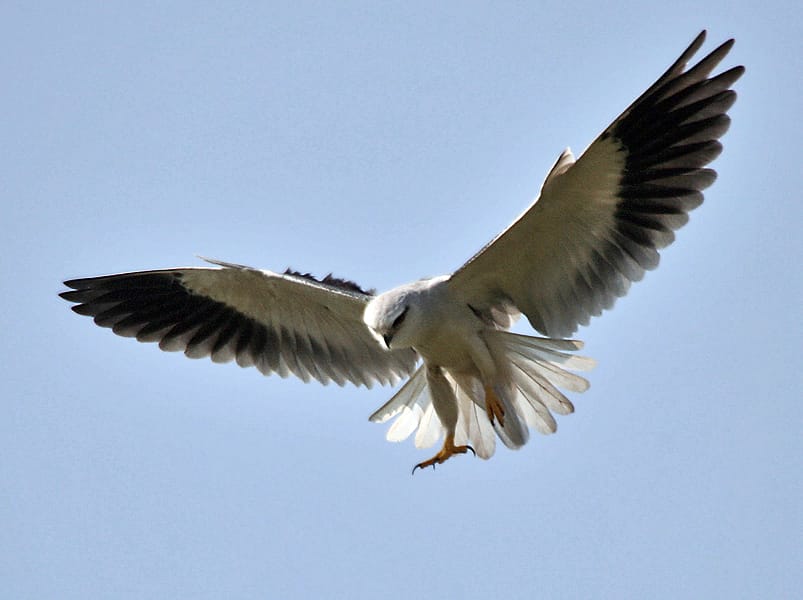
Physical Characteristics
Small-to-medium raptor, 35–38 cm long with a wingspan of 80–90 cm. Pale gray upperparts, white underparts, and striking black wing markings. Rounded wings and short tail aid in hovering flight.
Behavior
Diurnal hunter, often seen hovering over open fields before swooping on prey. Highly territorial and solitary.
Habitat and Range
Found across Africa, Europe, and Asia in grasslands, savannahs, and cultivated areas.
Diet
Feeds mainly on rodents and large insects. Uses keen eyesight and hovering behavior to locate prey.
Reproduction and Life Cycle
Nests in trees or shrubs; clutch size 3–4 eggs. Incubation lasts ~30 days. Fledglings leave the nest after ~4–5 weeks.
Fun Facts / Unique Traits
• Can hover like a kestrel when hunting.
• Often called the “Black-winged Falcon” due to wing coloration and hunting style.
Human Interaction
Beneficial predator for rodent control in agricultural areas; rarely causes conflict with humans.
26. White-tailed Kite (Elanus leucurus)
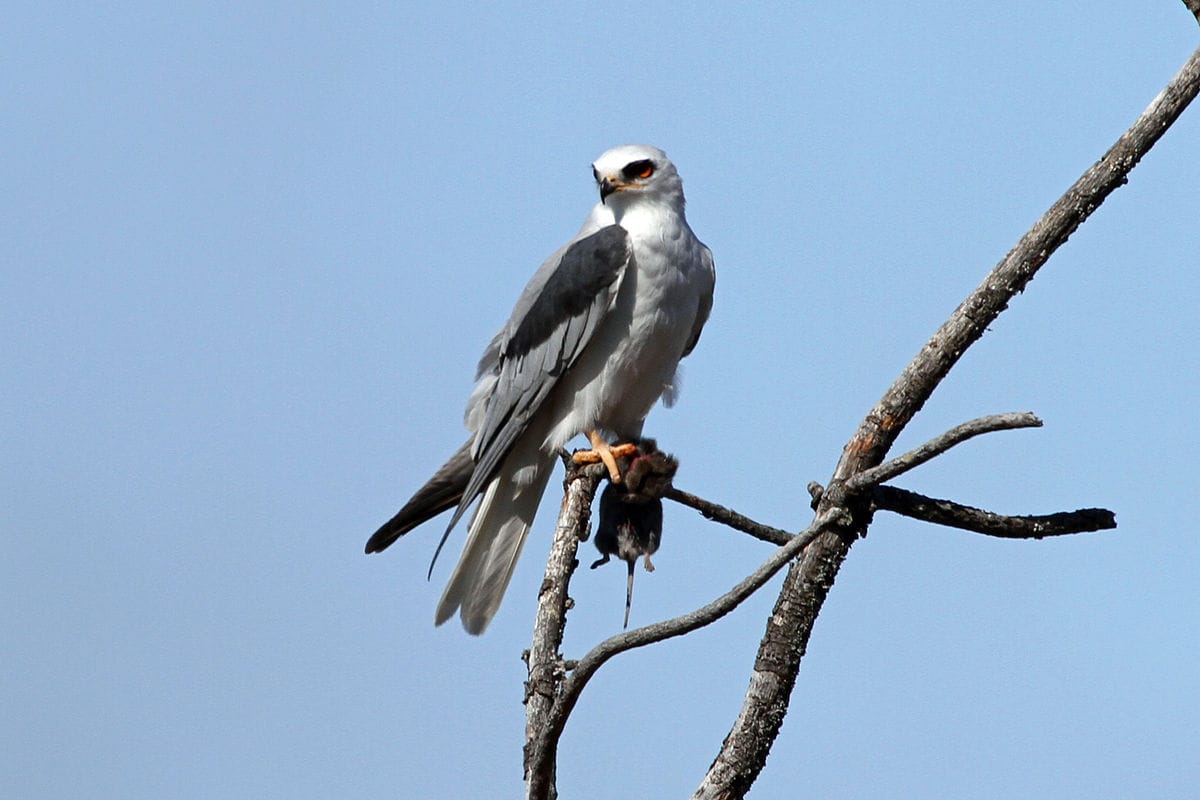
Physical Characteristics
The White-tailed Kite is a medium-sized raptor, 38–43 cm in length with a wingspan of 95–105 cm. It has striking white underparts, grey upperparts, and black shoulders. Its long white tail is distinctive during flight.
Behavior
Known for hovering gracefully over open fields while hunting. Hunts small mammals primarily by dropping silently from a hover onto its prey.
Habitat and Range
Found across the Americas, especially in the western United States, Central America, and northern South America. Prefers grasslands, open savannahs, and marsh edges.
Diet
Feeds mainly on small mammals such as mice and voles. Occasionally takes small birds and insects.
Reproduction and Life Cycle
Nests in shrubs or trees, laying 2–4 eggs per clutch. Incubation lasts about 30 days. Fledglings leave the nest after ~5 weeks.
Fun Facts / Unique Traits
• Exceptional hovering ability allows it to hunt with precision.
• Often seen gliding silently with wings held in a shallow “V” shape.
Human Interaction
Non-aggressive and beneficial in controlling rodent populations in agricultural lands.
________________________________________
27. Black Kite (Milvus migrans)
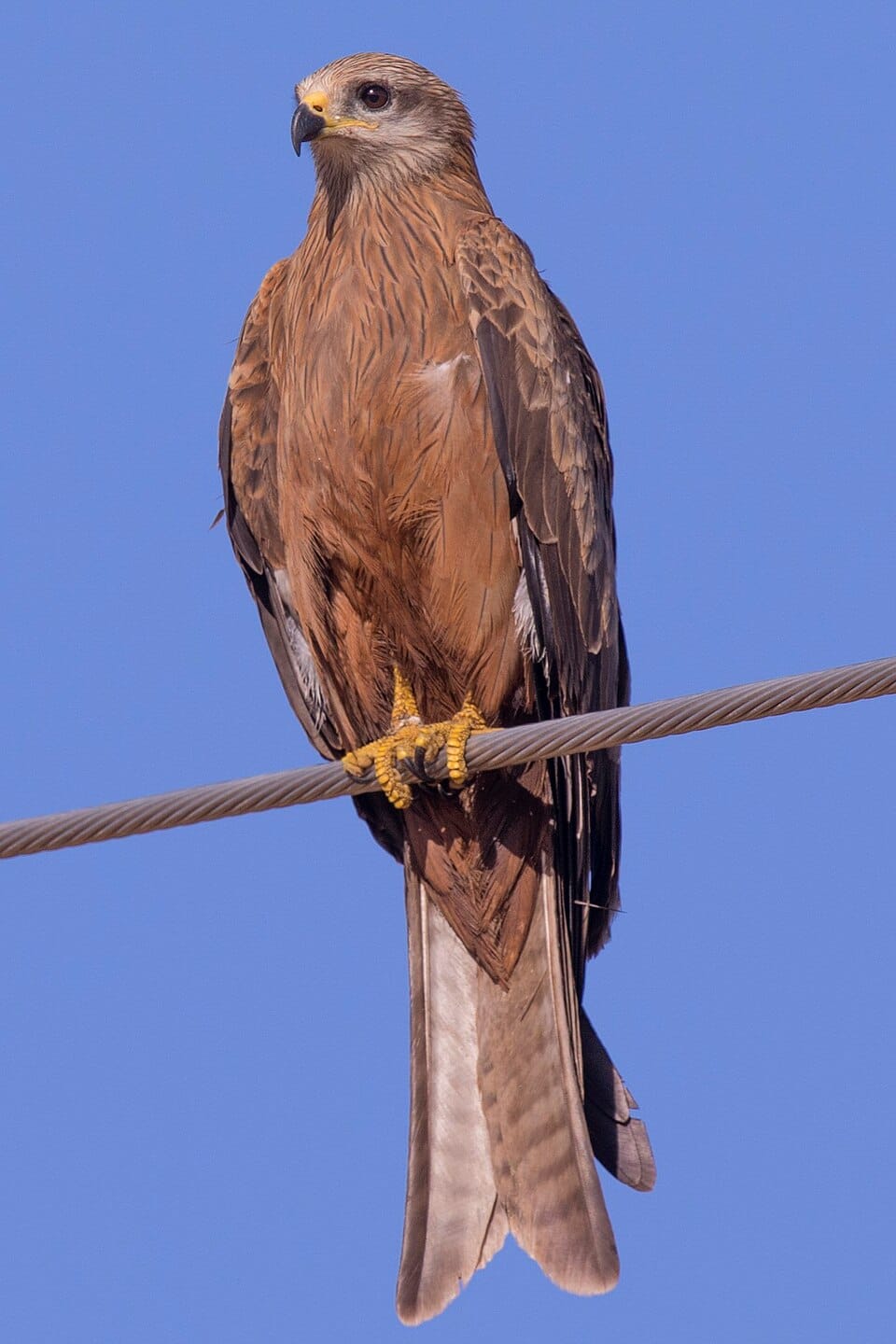
Physical Characteristics
Medium-sized raptor, 50–60 cm long with a wingspan of 140–155 cm. Dark brown plumage, forked tail, and yellow legs. Slightly lighter underparts distinguish it from similar species.
Behavior
Highly adaptable scavenger and hunter. Soars effortlessly in thermals while searching for carrion or small prey. Social, often gathering in large roosts.
Habitat and Range
Widely distributed across Europe, Asia, Africa, and Australia. Inhabits open forests, savannahs, wetlands, and urban areas.
Diet
Opportunistic; feeds on carrion, small mammals, insects, and occasionally fish. Skilled at catching prey mid-air or from the ground.
Reproduction and Life Cycle
Nests in trees or cliffs; clutch size 2–4 eggs. Incubation ~30 days. Fledglings leave nest after ~6 weeks.
Fun Facts / Unique Traits
• Known for impressive communal roosting behavior.
• Highly adaptable to human-altered landscapes.
Human Interaction
Common in urban areas; helps clean up carrion and reduce pest populations.
________________________________________
28. Red Kite (Milvus milvus)
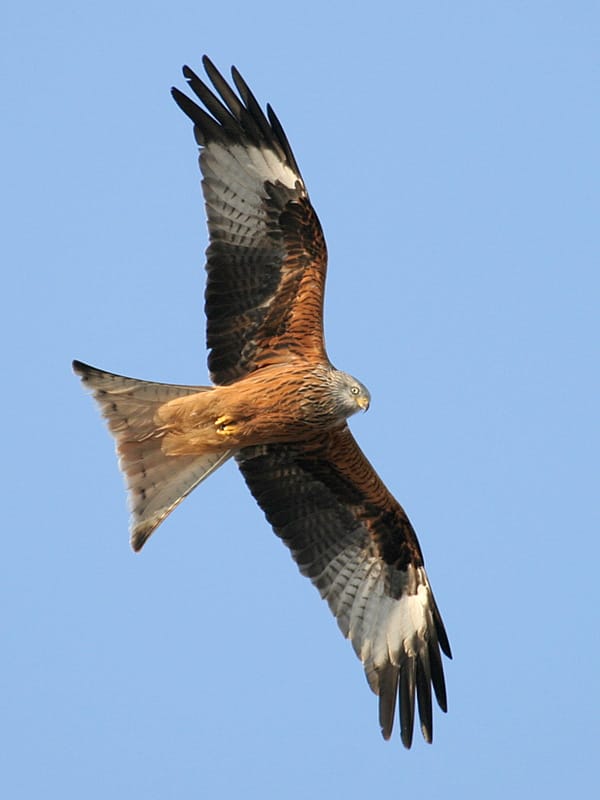
Physical Characteristics
Medium raptor, 60–70 cm long with a wingspan of 175–195 cm. Rusty-red body, forked tail, and pale head make it easily identifiable.
Behavior
Graceful soarer; glides and hovers while searching for carrion and small prey. Often seen in family groups or small flocks.
Habitat and Range
Native to Europe, particularly the UK, Germany, and Spain. Prefers open countryside with scattered trees, river valleys, and farmland.
Diet
Primarily scavenger; consumes carrion, small mammals, birds, and invertebrates.
Reproduction and Life Cycle
Nests in tall trees; clutch size 2–4 eggs. Incubation lasts ~31 days. Fledglings leave nest after ~7 weeks.
Fun Facts / Unique Traits
• Reintroduced successfully in several parts of Europe after population decline.
• Easily recognized by its graceful flight and forked tail.
Human Interaction
Valued in ecotourism and birdwatching; plays a role in cleaning carrion in rural landscapes.
________________________________________
29. Yellow-billed Kite (Milvus aegyptius)
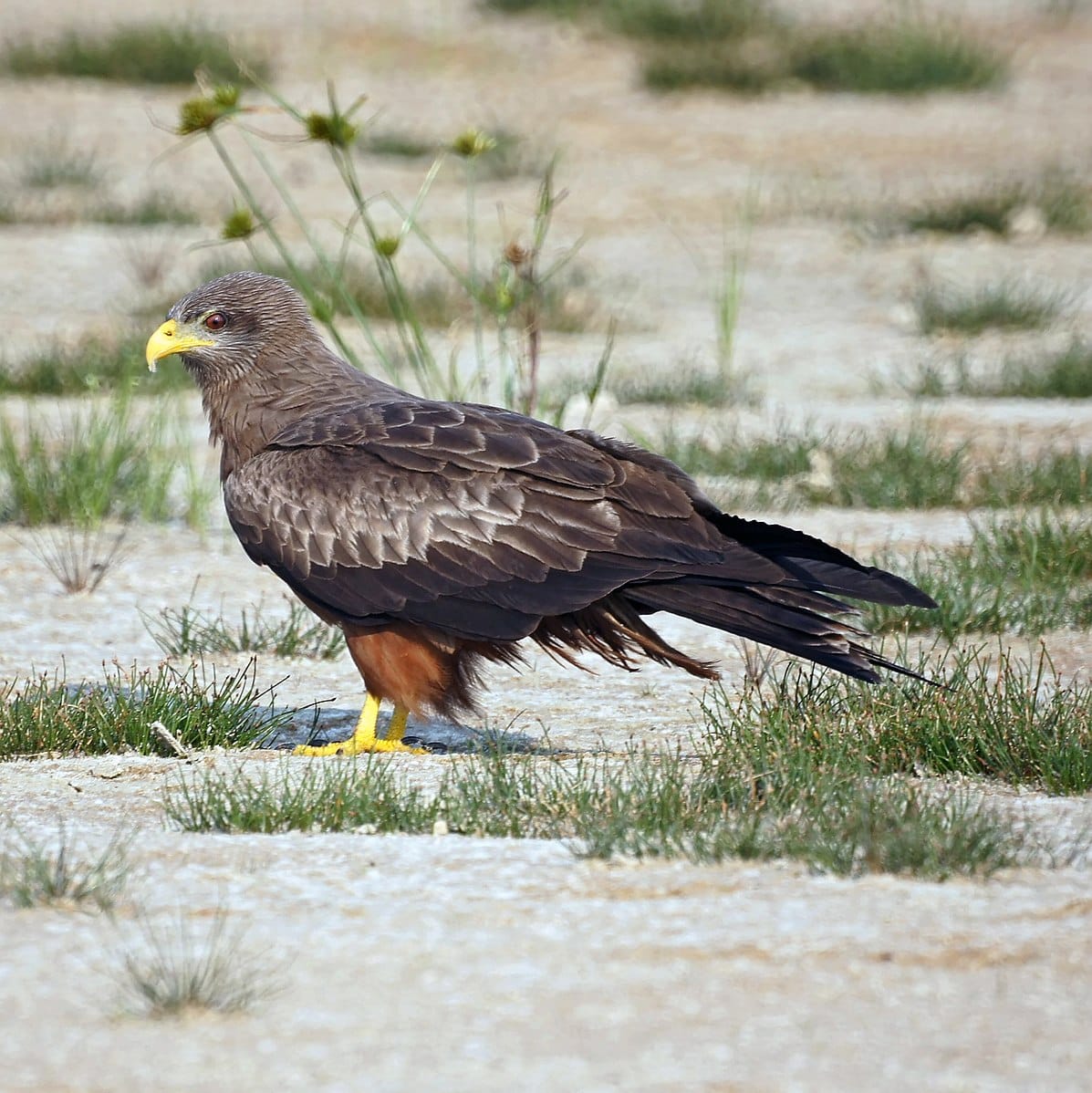
Physical Characteristics
Medium raptor, 55–60 cm long with a wingspan of 130–145 cm. Brown plumage with paler underparts and distinctive yellow bill. Forked tail aids in agile flight.
Behavior
Active hunter and scavenger. Soars over savannahs and woodlands, hovering occasionally to spot prey. Often forms communal roosts.
Habitat and Range
Widespread in sub-Saharan Africa and parts of the Middle East. Prefers open woodlands, savannahs, wetlands, and near human settlements.
Diet
Opportunistic, feeding on carrion, insects, small mammals, and reptiles. Skilled at scavenging and aerial hunting.
Reproduction and Life Cycle
Nests in trees or cliffs; lays 2–3 eggs per clutch. Incubation lasts ~30 days. Fledglings leave the nest after 5–6 weeks.
Fun Facts / Unique Traits
• Often migratory, traveling long distances seasonally.
• Known for impressive aerial agility.
Human Interaction
Helps control pests and scavenges effectively, often seen near rural communities.
________________________________________
30. Brahminy Kite (Haliastur indus)
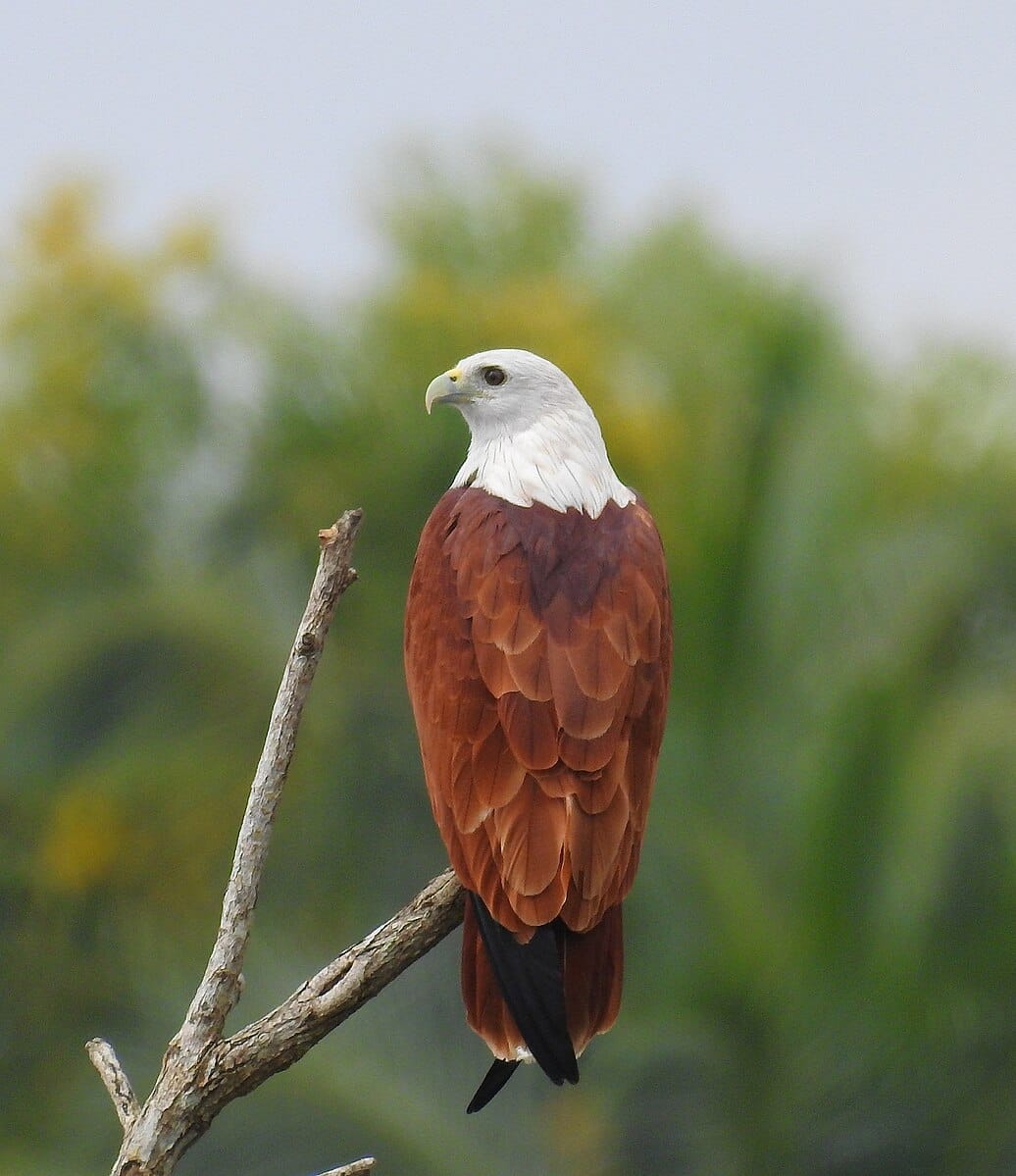
Physical Characteristics
Medium raptor, 44–52 cm long with a wingspan of 110–125 cm. Chestnut body, white head and breast, and broad wings distinguish it in flight.
Behavior
Soars gracefully along coastlines and rivers. Feeds primarily on carrion and fish. Frequently seen gliding over wetlands.
Habitat and Range
Found across South and Southeast Asia, Australia, and some Pacific islands. Prefers coastal areas, rivers, wetlands, and estuaries.
Diet
Carrion, fish, crustaceans, and occasionally small birds. Opportunistic feeding strategies include scavenging and hunting along water bodies.
Reproduction and Life Cycle
Nests in trees or cliffs, usually near water. Clutch size 2–3 eggs. Incubation ~26–28 days; fledglings leave nest after ~5 weeks.
Fun Facts / Unique Traits
• Often called the “Red-backed Sea Eagle.”
• Holds cultural significance in parts of India and Southeast Asia.
Human Interaction
Non-threatening to humans; valued for its role in cleaning fish waste and carrion in coastal ecosystems.
Frequently Asked Questions About Hawks
1. What is the most common type of hawk?
The Red-tailed Hawk is the most common hawk in North America, easily recognizable by its reddish-brown tail and broad wings.
2. What is the strongest type of hawk?
The Northern Goshawk is considered the strongest hawk due to its powerful talons and aggressive hunting skills.
3. Is a vulture a hawk?
No, vultures belong to the family Accipitridae but are scavengers, while hawks are active hunters.
4. Is an osprey a hawk?
No, ospreys belong to their own family (Pandionidae) and are specialized fish-eating raptors, though they share some characteristics with hawks.
5. What is the most famous hawk?
The Red-tailed Hawk is the most famous hawk, often featured in films, wildlife documentaries, and falconry.
6. What is the smartest hawk?
The Cooper’s Hawk is considered one of the smartest hawks because of its problem-solving skills and strategic hunting techniques.
7. Who is stronger, eagle or hawk?
Eagles are stronger than hawks. They are larger, have more powerful talons, and can hunt bigger prey.
8. What is the most rare hawk?
The Ridgway’s Hawk and Grey Hawk are among the rarest hawks in the world, with very limited populations.
9. Who eats a hawk?
Adult hawks have few natural predators, but larger birds of prey, such as eagles and great horned owls, may attack them. Eggs and chicks are vulnerable to raccoons, snakes, and crows.
10. Is a falcon a hawk?
No, falcons belong to the Falconidae family. They are generally smaller, faster, and have different hunting techniques compared to hawks.
11. Would a hawk take a chicken?
Yes, large hawks like the Red-tailed Hawk and Cooper’s Hawk can prey on chickens if given the opportunity.
12. Could a hawk grab a cat?
It’s possible but extremely rare. Only very large hawks might attempt it, usually targeting small kittens rather than full-grown cats.
13. When God sends a hawk?
In many cultures, hawks are seen as messengers or symbols of focus, protection, and awareness. A hawk’s appearance is often interpreted as a sign to stay alert or observe closely.
14. How rare is a black hawk?
Black Hawks are uncommon but not extremely rare. The Common Black Hawk lives in parts of Central and South America.
15. What is a hawk afraid of?
Hawks are cautious of larger predators, humans, and aggressive birds like crows, which may mob them to protect their territory.
16. Has a hawk ever attacked a person?
Hawk attacks on humans are very rare and usually defensive, such as protecting their nest or chicks.
17. Were Blackhawks used in Vietnam?
This refers to the UH-60 Black Hawk helicopter, named after the Native American war leader. It’s not related to the bird.
18. Are nighthawks rare?
Nighthawks are not true hawks and are fairly common in North and South America, although their populations are declining in some areas.
19. Is a hawk a good pet?
Hawks are wild raptors and are not suitable as pets. They require specialized care and permits to keep in captivity.
20. Why does a hawk visit you?
Seeing a hawk nearby often means there’s prey in the area, or it’s scouting territory. In cultural symbolism, it can also represent vigilance and awareness.
21. Will a crow fight a hawk?
Yes, crows often mob hawks to protect their nests, dive-bombing them to drive them away.
22. What is hawks’ biggest enemy?
Humans, habitat loss, and larger birds of prey are hawks’ biggest threats. Eggs and chicks are vulnerable to snakes, raccoons, and crows.
23. Who wins hawk vs owl?
It depends on the situation. Owls are nocturnal and stealthy hunters, while hawks are faster and more agile in daylight. Typically, they avoid direct confrontation.
24. Why do crows dislike hawks?
Crows dislike hawks because hawks are predators that threaten them and their nests. Crows actively mob hawks to protect their territory.
25. Who wins, falcon or hawk?
Falcons are faster and excel in aerial attacks, while hawks are stronger and more versatile hunters. In direct fights, it depends on species size and context.
26. Is a hawk a dinosaur?
Hawks are modern birds, and birds in general are descendants of theropod dinosaurs. So, in a way, yes, they share ancestry with dinosaurs.
27. What is a royal hawk?
A Royal Hawk usually refers to larger, powerful hawks like the Northern Goshawk or Red-tailed Hawk, symbolizing nobility or dominance in falconry.
28. What is the smartest hawk in the world?
The Cooper’s Hawk is considered highly intelligent for problem-solving and strategic hunting techniques.
29. Is an osprey a hawk?
No, ospreys are fish-eating raptors in their own family (Pandionidae) but share some similarities with hawks.
30. What’s the biggest thing a hawk can pick up?
Large hawks like the Red-tailed Hawk can carry prey weighing up to 2–3 pounds, such as rabbits, squirrels, or medium-sized birds.
31. Are hawks deaf?
No, hawks have excellent hearing that helps them detect prey, especially in dense forests.
32. What’s the strongest hawk?
The Northern Goshawk and Red-tailed Hawk are considered the strongest hawks, known for their powerful talons and flight muscles.
Conclusion
The world of hawks is incredibly diverse, ranging from small, agile forest hunters like the Collared Falconet to large, soaring raptors such as the Red Kite and Brahminy Kite. Across continents, hawks have adapted to a variety of habitats, including forests, grasslands, wetlands, and urban areas, demonstrating remarkable versatility and survival skills. Their keen eyesight, powerful talons, and strategic hunting behaviors make them apex predators in many ecosystems, playing a vital role in maintaining ecological balance.
Understanding these types of hawks not only highlights their fascinating biology and unique traits but also emphasizes their importance in biodiversity conservation. From controlling rodent populations to scavenging carrion, hawks contribute significantly to human-influenced landscapes while remaining largely unobtrusive. By appreciating their behavior, habitat preferences, and interactions with humans, we can foster awareness and support efforts to protect these magnificent birds of prey for future generations.
